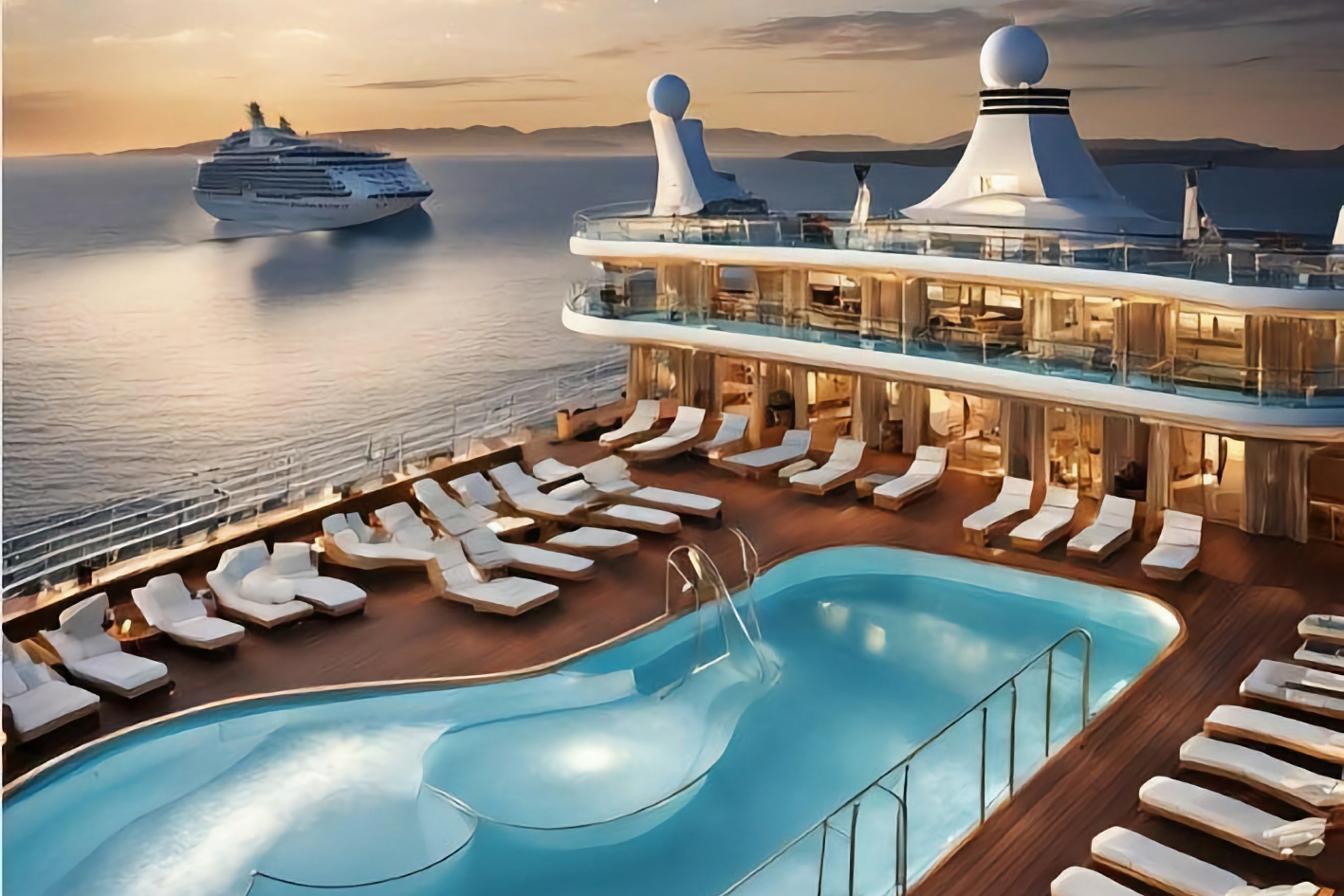Itinerary
Dublin is making a comeback. The decade-long “Celtic Tiger” boom era was quickly followed by the Great Recession, but The Recovery has finally taken a precarious hold. For visitors, this newer and wiser Dublin has become one of western Europe’s most popular and delightful urban destinations. Whether or not you’re out to enjoy the old or new Dublin, you’ll find it a colossally entertaining city, all the more astonishing considering its intimate size.It is ironic and telling that James Joyce chose Dublin as the setting for his famous Ulysses, Dubliners, and A Portrait of the Artist as a Young Man because it was a “center of paralysis” where nothing much ever changed. Which only proves that even the greats get it wrong sometimes. Indeed, if Joyce were to return to his once-genteel hometown today—disappointed with the city’s provincial outlook, he left it in 1902 at the age of 20—and take a quasi-Homeric odyssey through the city (as he so famously does in Ulysses), would he even recognize Dublin as his “Dear Dirty Dumpling, foostherfather of fingalls and dotthergills”?For instance, what would he make of Temple Bar—the city’s erstwhile down-at-the-heels neighborhood, now crammed with cafés and trendy hotels and suffused with a nonstop, international-party atmosphere? Or the simple sophistication of the open-air restaurants of the tiny Italian Quarter (named Quartier Bloom after his own creation), complete with sultry tango lessons? Or of the hot–cool Irishness, where every aspect of Celtic culture results in sold-out theaters, from Once, the cult indie movie and Broadway hit, to Riverdance, the old Irish mass-jig recast as a Las Vegas extravaganza? Plus, the resurrected Joyce might be stirred by the songs of Hozier, fired up by the sultry acting of Michael Fassbender, and moved by the award-winning novels of Colum McCann. As for Ireland’s capital, it’s packed with elegant shops and hotels, theaters, galleries, coffeehouses, and a stunning variety of new, creative little restaurants can be found on almost every street in Dublin, transforming the provincial city that suffocated Joyce into a place almost as cosmopolitan as the Paris to which he fled. And the locals are a hell of a lot more fun! Now that the economy has finally turned a corner, Dublin citizens can cast a cool eye over the last 20 crazy years. Some argue that the boomtown transformation of their heretofore-tranquil city has permanently affected its spirit and character. These skeptics (skepticism long being a favorite pastime in the capital city) await the outcome of “Dublin: The Sequel,” and their greatest fear is the possibility that the tattered old lady on the Liffey has become a little less unique, a little more like everywhere else.Oh ye of little faith: the rare ole gem that is Dublin is far from buried. The fundamentals—the Georgian elegance of Merrion Square, the Norman drama of Christ Church Cathedral, the foamy pint at an atmospheric pub—are still on hand to gratify. Most of all, there are the locals themselves: the nod and grin when you catch their eye on the street, the eagerness to hear half your life story before they tell you all of theirs, and their paradoxically dark but warm sense of humor. It’s expected that 2016 will be an extra-special year in the capital, as centenary celebrations of the fateful 1916 Easter Rising will dominate much of the cultural calendar.
Day itinerary:
Atmospheric cobbled streets with buskers scraping fiddles and characterful pubs inviting passersby inside is Dublin in a snapshot. Horse-drawn carriages plod along cobbled centuries-old streets blending with an easy-going cosmopolitan outlook. Known for its fun-filled gathering of pubs any excuse works to enjoy a celebratory toast and chat among good company. Home to perhaps the world’s most famous beer – slurp perfect pourings of thick dark Guinness – cranked out for the city’s thirsty punters. Learn more of the humble pint’s journey at the Guinness Storehouse. Dublin has come along way since the Vikings established a trading port here back in the 9th Century. In the time since the city became the British Empire’s defacto second city and the Georgian imprint still adds oodles of historic character. Learn of 1916’s Easter Uprising when the Irish rebelled and established their independence here as you visit the infamous haunting Kilmainham Gaol. The uprising’s leaders were tried and executed in these dark confines. Dublin’s St. Patrick’s Cathedral has immense history below its steep spire which dates back to 1191. There’s rich literary heritage to leaf through too and the city’s streets were rendered vividly in James Joyce’s classic Ullyses. The Museum of Literature celebrates the full scope of Dublin’s lyrical talents. Trinity College also has a prestigious roll-call of alumni – visit to see the Book of Kells a beautifully illustrated bible of the medieval era.
The Isle of Man, situated in the Irish Sea off the west coast of England, is a mountainous, cliff-fringed island and one of Britain’s most beautiful spots. Measuring just 30 miles by 13 miles, the Isle of Man remains semi-autonomous. With its own postage stamps, laws, currency, and the Court of Tynwald (the world’s oldest democratic parliament), the Isle of Man is rich with history and lore.Inhabited from Neolithic times, the island became a refuge for Irish missionaries after the 5th Century. Norsemen took the island during the 9th Century and sold it to Scotland in 1266. However, since the 14th Century, it has been held by England. Manx, the indigenous Celtic language, is still spoken by a small minority. The Isle of Man has no income tax, which has encouraged many Britains to regard the island as a refuge. Otherwise, it is populated by Gaelic farmers, fishermen, and the famous tailless manx cats. The varied landscape features austere moorlands and wooded glens, interspersed by fine castles, narrow-gauge railways, and scores of standing stones with Celtic crosses. The hilly terrain rises to a height of 2,036 feet at Mount Snaefell, which dominates the center of the island.
Day itinerary:
The Isle of Man, off England’s west coast (and Ireland’s east) needs no introduction. Its Celtic history is legendary, its political past labyrinthine and its national symbol – a three legged figure with neither body nor head – an enigma that has been foxing historians for centuries. Do not confuse the Isle of Man with the United Kingdom. It does have “crown dependency” similar to Jersey, but the 32-mile-long island is entirely self-governed. It changed hands between England and Scotland many times during the middle ages but fell under British rule in 1399. However, when the feudal lordship was revested in 1765, the island never became part of the United Kingdom. And has remained independent ever since.
The stunning Isle of Lunga is the largest island in the Treshnish archipelago. With volcanic origin the isle was populated until the 19th Century, and remains of black houses can be seen around this magnificent coastal jewel. Abundant plant life and exotic birdlife are now the main inhabitants of the area. Fortunate visitors view the magnificent array of birds, especially the great puffins that breed on the islands plateau. One can sit within just a few feet away without disturbing the avian ambassador’s peace. The 81 hectare island is home to many rare and endangered plants such as, primroses and orchids. Views over the landscape and across the ocean can be seen from the 300 foot high cliffs.
Day itinerary:
The stunning Isle of Lunga is the largest island in the Treshnish archipelago. With volcanic origin the isle was populated until the 19th Century and remains of black houses can be seen around this magnificent coastal jewel. Abundant plant life and exotic birdlife are now the main inhabitants of the area. Fortunate visitors view the magnificent array of birds especially the great puffins that breed on the islands plateau. One can sit within just a few feet away without disturbing the avian ambassador’s peace. The 81 hectare island is home to many rare and endangered plants such as primroses and orchids. Views over the landscape and across the ocean can be seen from the 300 foot high cliffs.
With a population of 120 residents, Iona is Located off the Southwest of Mull. The island is 3 miles long and 1.5 miles wide but draws in thousands of visitors each year due to its natural beauty and historical interest. Saint Columba and his fellow monks landed here in 563. This beautiful stretch of coastline brings out the true beauty of Iona facing onto the Gulf Stream that gives the island its mild climate. Located to the south of the road lies Sìthean Mòr (Large fairy hill) and alternatively known as the Hill of Angels, this is said to have been the setting for many rituals and traditions dating far back in history. This wonderful highlight, Iona Abbey was founded by Saint Columba in 563 and is said to have survived many Viking attacks. Although little remains of the monastic buildings of this period, the magnificent Abbey is the main attraction.
Day itinerary:
If tiny islands that resonate with peace and tranquillity are your idea of travel heaven, then welcome to Iona. Almost 200 miles east of Edinburgh, set in Scotland’s Inner Hebrides, this magical island has a spiritual reputation that precedes it. And luckily, more than lives up to. The island is miniscule. Just three miles long and only one and a half miles wide, this is not a place that hums with urban attractions. 120 people call Iona home (this number rises significantly if the gull, tern and Kittiwake population is added), although residential numbers do go up (to a whopping 175) in summer. The beautiful coastline is lapped by the gulf stream and gives the island a warm climate with sandy beaches that look more Mediterranean than Scottish! Add to that a green field landscape that is just beautiful, and you’ll find that Iona is a place that stays with you long after you leave. Iona’s main attraction is of course its abbey. Built in 563 by Saint Columbia and his monks, the abbey is the reason why Iona is called the cradle of Christianity. Not only is the abbey (today an ecumenical church) one of the best – if not the best – example of ecclesiastical architecture dating from the Middle Ages, but it also serves as an important site of spiritual pilgrimage. St. Martin’s Cross, a 9th century Celtic cross that stands outside the abbey, is considered as the finest example of Celtic crosses in the British Isles. Rèilig Odhrain, or the cemetery, allegedly contains the remains of many Scottish kings.
Day itinerary:
Cliffs of tall hexagonal columns create a sensational landscape at the Shiant Islands, especially when viewed from the sea. The cliffs of six-sided rock columns look like the cross-section of an enormous honeycomb. The rock formations were formed when molten volcanic magma cooled very slowly underground. Millions of years of erosion has exposed the six-sided columns to the sea, and to us. The tallest of these formations is 120 metres (390 feet) high. During spring and summer, flights of seabirds near the Shiant Islands catch the eye. Many long-winged seabirds wheel and soar gracefully. Others are more shaped for underwater swimming and fly in direct lines, beating stubby wings to resemble flying potatoes. Some birds nest in burrows while others, like Black-legged Kittiwakes, nest on cliffs. Rather than build nests, guillemots lay eggs on bare rock ledges. The pointed shape of the eggs ensures they roll in a tight circle, not off the ledge to the sea below. The Shiant Islands are part of the Outer Hebrides and located between the Isles of Lewis and Skye. Historically, they have supported families of sheep grazers who could tolerate a lonely island outpost. The Shiants were known as the last place in Britain where the Black Rat occurred in substantial numbers. Originally introduced to Britain from Asia in Roman times these rodents caused problems, eating eggs and chicks of seabirds. A successful eradication program eliminated the rats in 2016, giving the seabird colonies well-earned peace.
Day itinerary:
Loch Ewe is the only north facing Loch in Scotland, with an interesting history and a fine scenic landscape this area has a true natural beauty. During WW2 the loch was a convoy collecting point with a strong naval presence; it was therefore protected by light and heavy aircraft guns, a boom net and mine defence system helped to shield this precious settlement. Loch Ewe is a natural deep water sea loch that links to the Atlantic Ocean with a relatively small mouth giving the loch a vast amount of protection from the weather. Nearby Inver ewe gardens thrive on the warm currents of the North Atlantic Drift to create an oasis of colour and fertility where exotic plants from many countries flourish on latitude more northerly than Moscow, giving an almost continual display of colour throughout the year.
St Kilda is a remarkable uninhabited archipelago some 40 nautical miles beyond the Outer Hebrides. The stunning cliffs and sea stacks are home to the most important seabird breeding colony in northwest Europe. St Kilda is one of the few places in the world to have received dual World Heritage status from UNESCO in recognition of its Natural Heritage and cultural significance. Village Bay on the island of Hirta once supported a population of over 200, but the last islanders left in the 1930s. Recent restoration work on the village by the National Trust for Scotland offers a marvellous link with the past. One of the caretakers acts as shopkeeper and postmaster for any visitors who might like to send a postcard home from St. Kilda.
Day itinerary:
Gloriously remote, St. Kilda is an archipelago 50 miles off the Isle of Harris. Although the four islands are uninhabited by humans, thousands of seas birds call these craggy cliffs home, clinging to the sheer faces as if by magic. Not only is St. Kilda home to the UK’s largest colony of Atlantic Puffin (almost 1 million), but also the world largest colony Gannets nests on Boreray island and its sea stacks. The islands also home decedents of the world’s original Soay sheep as well as having a breed of eponymously named mice. The extremely rare St. Kilda wren unsurprisingly hails from St. Kilda, so birders should visit with notebook, binoculars and camera to hand. While endemic animal species is rife on the island, St. Kilda has not been peopled since 1930 after the last inhabitants voted that human life was unsustainable. However, permanent habitation had been possible in the Medieval Ages, and a vast National Trust for Scotland project to restore the dwellings is currently being undertaken. The islands even enjoyed a status as being an ideal holiday destination in the 19th century. Today, the only humans living on the islands are passionate history, science and conservation scholars. One of the caretakers even acts as shopkeeper and postmaster for any visitors who might like to send a postcard home from St. Kilda. It should be noted that St. Kilda is the UKs only (and just one of 39 in the world) dual World Heritage status from UNESCO in recognition of its Natural Heritage and cultural significance.
More than 600 miles (nearly 1,000 kilometres) from Denmark’s west coast lie the Faroes, a triangle of eighteen windswept islands, seventeen of which are inhabited. Only 48,500 people plus some 70,000 sheep roam these remote lands. Much of the islands’ heritage reflects a medieval past, beginning with the arrival of farmers from western Norway who settled here in the 9th century. Evidence of this Scandinavian heritage is preserved through centuries of isolation; ancient structures can still be seen in villages clustered around old churches. Sheer cliffs and waterfalls carve Streymoy, the largest of the islands, where Torshavn is one of the world’s smallest capitals with about 12,400 inhabitants, plus another 5,000 living in the suburbs of Argir and Hoyvik. Visitors find interesting museums, churches, monuments and all the amenities of a modern town and thriving harbour here. The world’s oldest, still active parliament was founded in the Viking age. Today, it houses the main offices of the local government. Many of the attractions are found outside of Torshavn in the rugged beauty of Streymoy. There are fields with grazing ponies and sheep, tiny hamlets where residents live in half-timbered houses topped by green grass roofs, and dramatic rock formations. Birds by the thousands populate the craggy seaside cliffs, which make an ideal stopover for migratory gannets, guillemots and puffins. The Faroes’ climate is generally wet and windy. Because of the Gulf Stream, the temperature is a good deal more moderate than the latitude might imply; it also helps to keep Faroe harbours ice-free year-round.
Day itinerary:
Titanic scenery mist-whipped mountains and staggering oceanic vistas await you here in the Faroe Islands – a far-flung archipelago of immense natural beauty. This remote and isolated gathering of 18 islands – adrift in the far North Atlantic Ocean – is a self-governing part of the Kingdom of Denmark and colourful Tórshavn bustles up against the seafront forming one of the tiniest capital cities in the world. Wander between pretty half-timbered houses and visit one of the world’s oldest parliament buildings during your time here. With Viking history swirling too Torshavn is a quaint charming and heritage-rich city. Surrounded by thrilling landscapes and cosy Scandi culture the Faroe Islands are an envy-inducing off-the-beaten-track destination. From Torshavn scatter to your choice of island destinations or spend time soaking in the storybook appeal and clarity of air in the scenic old town. Pop into local shops or head for restaurants – where you can taste local foods like salt-cured fish and hunks of lamb. See waterfalls plummeting directly into the ocean from vertical cliffs along with emerald-green carpeted fjords as you explore these extraordinary lost islands. Puffins and sea birds relish the island’s craggy sea cliffs and coastline – visit the island of Mykines to see the birds burrowing deep into the steep cliffs to nest. Fjords etch into the coastline and you can encounter peaceful lakes and massive valleys dug out by glaciers. Off-shore sea stacks totter up out of the swelling frothy waves.
The Vestmanna bird cliffs are near vertical, volcanic cliffs that rise steeply out of the ocean to a height of over 600 meters. They are impressively covered with innumerable bird nesting sites as well rare and hardy vegetation. Literally tens of thousands of seabirds can be seen soaring along the cliffs, sitting on nests as well as swimming across the water. Species include numerous kittiwakes, Common Guillemots, Black Guillemots and the endearing Atlantic Puffin. In addition, several waterfalls cascade down in graceful mists from hundreds of meters in the air and explorations reveal a series of sea caves ranging from modest in size to enormous.
Day itinerary:
Surrounded by the mountains of Hægstafjall, Økslin, Loysingafjall, and Moskurfjall, Vestmanna sits quietly on the banks of Streymoy, on the North Atlantic Ocean. With 1,200 inhabitants, the colourful little village itself is lovely; a few shops and cafes selling locally made cakes and handicrafts, as well as the island’s native seafood soup dish. While those wishing to stretch their legs will enjoy the surrounding area for its stunning countryside, Vestmanna’s main attraction is beyond any doubt its bird cliffs. Youi don’t have to be a birder to appreciate these magnificent cliffs, although if you are the cliffs are the stuff of dreams. At almost 700-metres high (and six kilometres long), the cliffs rise steeply out of the water and are covered with tens of thousands of seabirds, zooming through the air, swooping into the water and nesting in the crevices. The near vertical cliffs are home to numerous species including kittiwakes, Common Guillemots, Black Guillemots and the oh so charismatic Atlantic Puffin. Visually, they are stunning: waterfalls thunder into the sea, cliff tops cut jagged lines into horizon and the whole landscape seems straight out of Jurassic Park. Dressed in a cloak of mist and emerald green moss, to say that the feeling is otherworldly is an understatement. To gage the true beauty of the region, one must take to the sea. The experience of sailing under the cacophonic cliffs, juxtaposed by the silence of calm caves is simply unforgettable.
Founded by Dutch fishermen in the 17th century, Lerwick today is a busy town and administrative center. Handsome stone buildings—known as lodberries—line the harbor; they provided loading bays for goods, some of them illegal. The town’s twisting flagstone lanes and harbor once heaved with activity, and Lerwick is still an active port today. This is also where most visitors to Shetland dock, spilling out of cruise ships, allowing passengers to walk around the town.
Day itinerary:
Adrift between the Scottish and Norwegian coasts the craggy Shetland Islands form the most northerly point of the British Isles. Sprawling across 100 islands connected by sandy bridges and crisscrossing ferries explore the highlights of this scenic archipelago outpost. Look out over dramatic coastline from atmospheric Iron Age towers. Sweeping windswept beaches and wisps of sand connect islands and rugged cliffs – stand back as the sounds of the waves smashing against the shore and calling gulls fills the air. The islands are also home to some of the most adorable four-legged creatures you’ll ever meet the diminutive and wavy-fringed Shetland Ponies who roam the hills and reach a maximum size of 42 inches. Don’t be fooled though they are amongst the strongest and toughest of all breeds. Their existence here points to Viking history as local horses bred with ponies brought ashore by Norse settlers creating the lovable crossbreed that is an icon of these islands today. The towering Broch of Mousa is perhaps Europe’s best-preserved Iron Age building – and one of the Shetland’s finest brochs – a series of round stone towers believed to have been constructed around 100 BC. Seals and birdlife ensure that the isolated islands are always well-populated with life – and you can embark on hikes to discover their coastal homes. Lerwick is the islands’ capital and there’s a charming welcome on offer as you arrive before the waterfront of stone buildings which cascade down to the shore.
Day itinerary:
Lying mid-way between Shetland and the Orkney islands, Fair Isle is a tiny jewel in the sea. Famous for birds, knitwear and historic shipwrecks, the island offers a warm and friendly welcome to visitors. With a population of only around 70 people this island is truly a beautiful setting and is one of Britain’s most successful communities. View the cloudy light turquoise water as it drifts out to sea beneath the breath-taking Sheep Rock, rising over 100 metres, which is almost an isle of its own. Fair Isles oceanic climate brings stormy but fairly mild winters, in summer, you can expect rapid changes in the weather, sparkling sunshine can be followed by a thick blanket of mist and fog, and this makes the isle a truly inspiring area. Over the centuries the island has changed hands many times and was named the island of peace by Norse settlers. The isle has been a useful landmark for shipping but in storms and fog it is highly dangerous creating over 100 known shipwrecks such as the Spanish armada flag ship “El Gran Grifon”.
Edinburgh is to London as poetry is to prose, as Charlotte Brontë once wrote. One of the world’s stateliest cities and proudest capitals, it’s built—like Rome—on seven hills, making it a striking backdrop for the ancient pageant of history. In a skyline of sheer drama, Edinburgh Castle watches over the capitalcity, frowning down on Princes Street’s glamour and glitz. But despite its rich past, the city’s famous festivals, excellent museums and galleries, as well as the modern Scottish Parliament, are reminders that Edinburgh has its feet firmly in the 21st century. Nearly everywhere in Edinburgh (the burgh is always pronounced burra in Scotland) there are spectacular buildings, whose Doric, Ionic, and Corinthian pillars add touches of neoclassical grandeur to the largely Presbyterian backdrop. Large gardens are a strong feature of central Edinburgh, where the city council is one of the most stridently conservationist in Europe. Arthur’s Seat, a mountain of bright green and yellow furze, rears up behind the spires of the Old Town. This child-size mountain jutting 822 feet above its surroundings has steep slopes and little crags, like a miniature Highlands set down in the middle of the busy city. Appropriately, these theatrical elements match Edinburgh’s character—after all, the city has been a stage that has seen its fair share of romance, violence, tragedy, and triumph. Modern Edinburgh has become a cultural capital, staging the Edinburgh International Festival and the Fringe Festival in every possible venue each August. The stunning Museum of Scotland complements the city’s wealth of galleries and artsy hangouts. Add Edinburgh’s growing reputation for food and nightlife and you have one of the world’s most beguiling cities. Today the city is the second most important financial center in the United Kingdom, and the fifth most important in Europe. The city regularly is ranked near the top in quality-of-life surveys. Accordingly, New Town apartments on fashionable streets sell for considerable sums. In some senses the city is showy and materialistic, but Edinburgh still supports learned societies, some of which have their roots in the Scottish Enlightenment. The Royal Society of Edinburgh, for example, established in 1783 “for the advancement of learning and useful knowledge,” remains an important forum for interdisciplinary activities. Even as Edinburgh moves through the 21st century, its tall guardian castle remains the focal point of the city and its venerable history. Take time to explore the streets—peopled by the spirits of Mary, Queen of Scots; Sir Walter Scott; and Robert Louis Stevenson—and pay your respects to the world’s best-loved terrier, Greyfriars Bobby. In the evenings you can enjoy candlelit restaurants or a folk ceilidh (pronounced kay-lee, a traditional Scottish dance with music), though you should remember that you haven’t earned your porridge until you’ve climbed Arthur’s Seat. Should you wander around a corner, say, on George Street, you might see not an endless cityscape, but blue sea and a patchwork of fields. This is the county of Fife, beyond the inlet of the North Sea called the Firth of Forth—a reminder, like the mountains to the northwest that can be glimpsed from Edinburgh’s highest points, that the rest of Scotland lies within easy reach.
Day itinerary:
Just over ten miles to the north-west of Edinburgh Rosyth is a hearty welcome to Scotland’s scenery and sophistication. Cross beside the spectacular iron span of the Forth Bridge – a historic world heritage site that has been a Scottish landmark since 1889 – to reach Edinburgh’s treasures. Or historic Dunfermline is even closer where Robert the Bruce lies in rest along with 11 other Scottish monarchs from history. Most visitors to Rosyth will journey to Edinburgh – the elegant Scottish Capital which sprawls across a glorious setting of seven hills. An imposing 7th-century castle dominates proceedings crowning the city and perching on an elevated volcanic plug. Below you’ll find cobbled streets of endless historical charm. Bagpipes ring down the beautiful Royal Mile – a steep rise up from the Scottish Parliament building towards the castle. The magical cafes and eateries along this stretch have attracted fame as the locations where JK Rowling penned the Harry Potter novels – surely inspired by the historic charm all around her. Flower-dressed pubs serve those in need of a little refreshment or a dram or two of the local whiskies produced nearby. With royal pageantry world-class museums and uproarious festivities Edinburgh is a grand and beautiful – yet unpretentious and welcoming – city to absorb. Get the best view of Edinburgh by ascending to the summit of Arthur’s Seat. From this esteemed viewpoint you can admire an immense 360-degree view of the city’s skyline and look across the North Sea’s massive inlet back to the port at Rosyth.
Edinburgh is to London as poetry is to prose, as Charlotte Brontë once wrote. One of the world’s stateliest cities and proudest capitals, it’s built—like Rome—on seven hills, making it a striking backdrop for the ancient pageant of history. In a skyline of sheer drama, Edinburgh Castle watches over the capitalcity, frowning down on Princes Street’s glamour and glitz. But despite its rich past, the city’s famous festivals, excellent museums and galleries, as well as the modern Scottish Parliament, are reminders that Edinburgh has its feet firmly in the 21st century. Nearly everywhere in Edinburgh (the burgh is always pronounced burra in Scotland) there are spectacular buildings, whose Doric, Ionic, and Corinthian pillars add touches of neoclassical grandeur to the largely Presbyterian backdrop. Large gardens are a strong feature of central Edinburgh, where the city council is one of the most stridently conservationist in Europe. Arthur’s Seat, a mountain of bright green and yellow furze, rears up behind the spires of the Old Town. This child-size mountain jutting 822 feet above its surroundings has steep slopes and little crags, like a miniature Highlands set down in the middle of the busy city. Appropriately, these theatrical elements match Edinburgh’s character—after all, the city has been a stage that has seen its fair share of romance, violence, tragedy, and triumph. Modern Edinburgh has become a cultural capital, staging the Edinburgh International Festival and the Fringe Festival in every possible venue each August. The stunning Museum of Scotland complements the city’s wealth of galleries and artsy hangouts. Add Edinburgh’s growing reputation for food and nightlife and you have one of the world’s most beguiling cities. Today the city is the second most important financial center in the United Kingdom, and the fifth most important in Europe. The city regularly is ranked near the top in quality-of-life surveys. Accordingly, New Town apartments on fashionable streets sell for considerable sums. In some senses the city is showy and materialistic, but Edinburgh still supports learned societies, some of which have their roots in the Scottish Enlightenment. The Royal Society of Edinburgh, for example, established in 1783 “for the advancement of learning and useful knowledge,” remains an important forum for interdisciplinary activities. Even as Edinburgh moves through the 21st century, its tall guardian castle remains the focal point of the city and its venerable history. Take time to explore the streets—peopled by the spirits of Mary, Queen of Scots; Sir Walter Scott; and Robert Louis Stevenson—and pay your respects to the world’s best-loved terrier, Greyfriars Bobby. In the evenings you can enjoy candlelit restaurants or a folk ceilidh (pronounced kay-lee, a traditional Scottish dance with music), though you should remember that you haven’t earned your porridge until you’ve climbed Arthur’s Seat. Should you wander around a corner, say, on George Street, you might see not an endless cityscape, but blue sea and a patchwork of fields. This is the county of Fife, beyond the inlet of the North Sea called the Firth of Forth—a reminder, like the mountains to the northwest that can be glimpsed from Edinburgh’s highest points, that the rest of Scotland lies within easy reach.
Day itinerary:
Just over ten miles to the north-west of Edinburgh Rosyth is a hearty welcome to Scotland’s scenery and sophistication. Cross beside the spectacular iron span of the Forth Bridge – a historic world heritage site that has been a Scottish landmark since 1889 – to reach Edinburgh’s treasures. Or historic Dunfermline is even closer where Robert the Bruce lies in rest along with 11 other Scottish monarchs from history. Most visitors to Rosyth will journey to Edinburgh – the elegant Scottish Capital which sprawls across a glorious setting of seven hills. An imposing 7th-century castle dominates proceedings crowning the city and perching on an elevated volcanic plug. Below you’ll find cobbled streets of endless historical charm. Bagpipes ring down the beautiful Royal Mile – a steep rise up from the Scottish Parliament building towards the castle. The magical cafes and eateries along this stretch have attracted fame as the locations where JK Rowling penned the Harry Potter novels – surely inspired by the historic charm all around her. Flower-dressed pubs serve those in need of a little refreshment or a dram or two of the local whiskies produced nearby. With royal pageantry world-class museums and uproarious festivities Edinburgh is a grand and beautiful – yet unpretentious and welcoming – city to absorb. Get the best view of Edinburgh by ascending to the summit of Arthur’s Seat. From this esteemed viewpoint you can admire an immense 360-degree view of the city’s skyline and look across the North Sea’s massive inlet back to the port at Rosyth.
Ship features
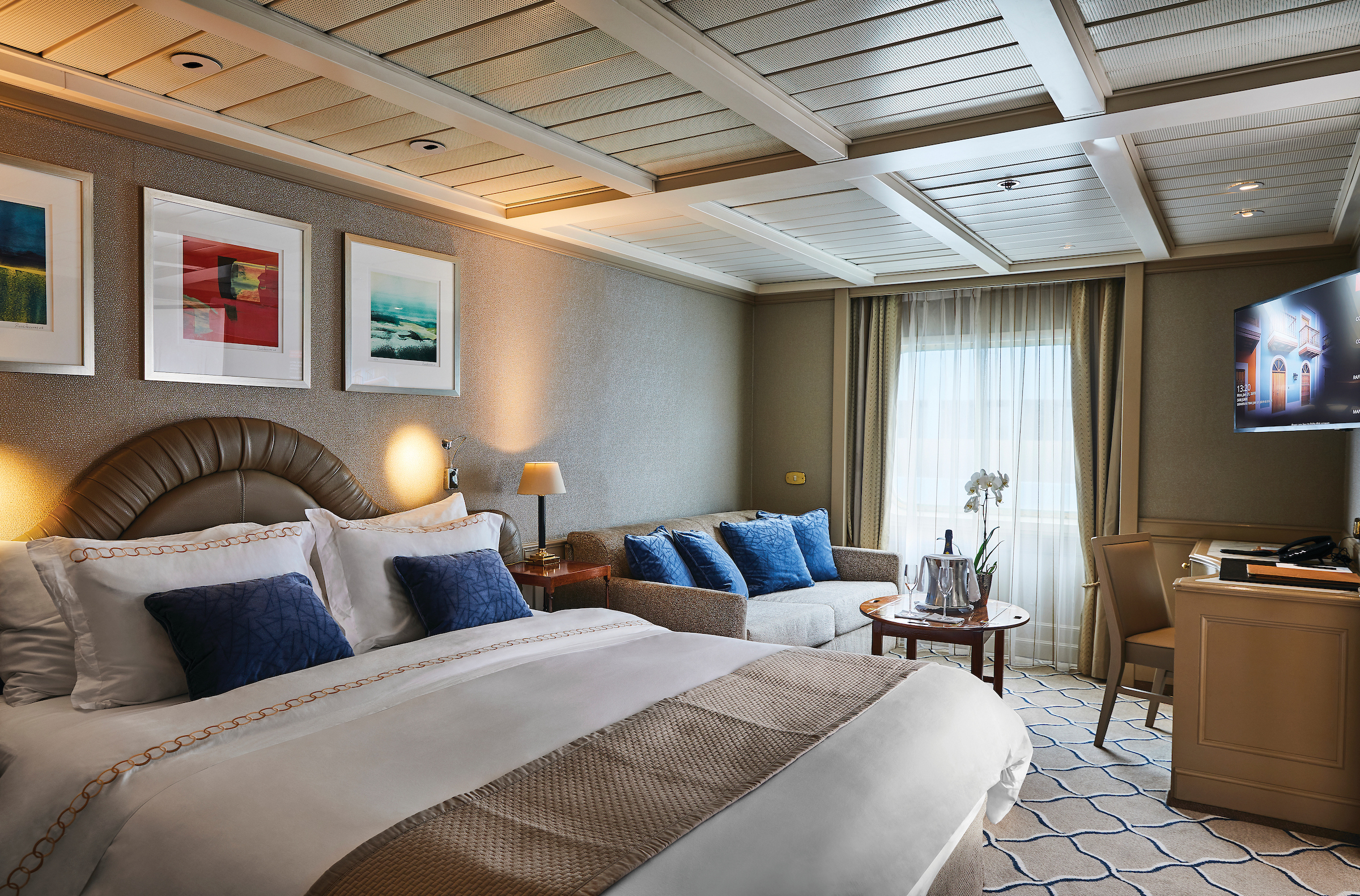
Owner's Suite
The name says it all. A stylish apartment. Prestigious and classic. For those who seek the superlative level of space, comfort and service on board. The Owner’s Suite is available as a one-bedroom configuration or as two bedrooms (as illustrated) by adjoining with a Vista Suite so you can enjoy your luxury cruise in style.
One bedroom: 55 sq.m. including veranda
Two bedroom: 77 sq.m. including veranda
Images and suite plans are intended as a general reference. Features, materials, finishes and layout maybe different than shown.
Please note that the 3rd guest will sleep on a comfortable sofa bed in the reception area of the suite.
Essentials
- Deck(s): 7
- Section: Mid-Ship
Characteristics
- Veranda
- Separate dining area
- Living room with sitting area
- Standard vanity
- Walk-in shower
- Whirlpool bath
- Walk-in wardrobe with personal safe
Furniture
- Queen size bed
- Writing desk
- Vanity table
- Luxury bed mattresses
Media & Communication
- Unlimited Premium Wi-Fi
- 2 large flat screen TVs with Interactive Media Library
- Sound system with bluetooth connectivity
- Direct dial telephone
- Wall mounted USB-C mobile device chargers
- Dual voltage 110/220 outlets
Onboard Services
- Butler service
- Complimentary laundry, pressing & wet cleaning
- Daily canapé service, Welcome chocolate, Welcome fruit stand
- Dinner for two in La Dame, one evening per voyage,
- Two hours of worldwide phone use, per voyage segment
- Champagne on arrival
Amenities
- Espresso machine
- Pillow menu
- Refrigerator and bar setup stocked with your preferences
- Plush bathrobe
- Luxury bath amenities
- Umbrella
- Hair Dryer
- Slippers
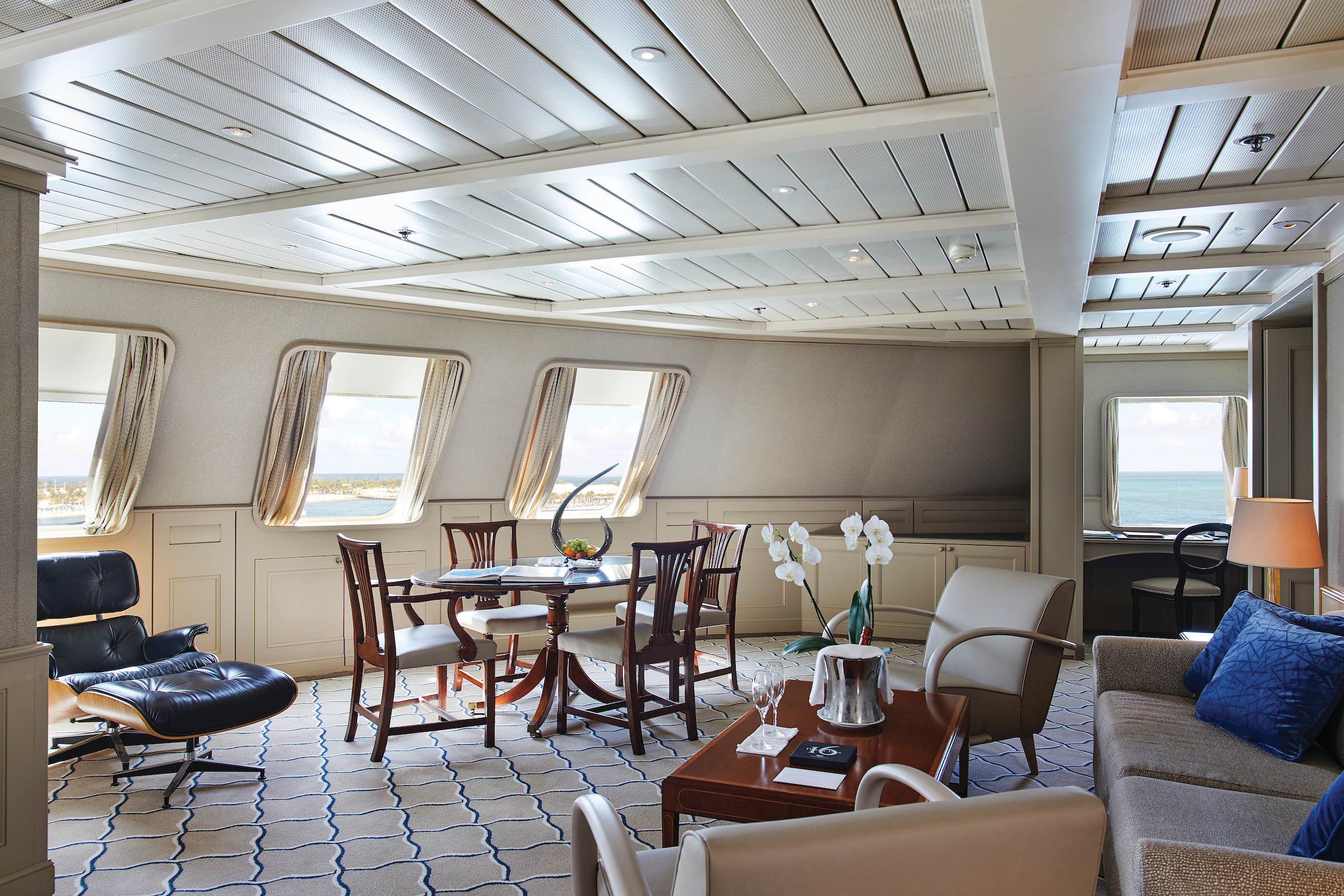
Grand Suite
Expertly designed and exquisitely appointed. The Grand Suite on the Silver Wind ideal for entertaining friends or enjoying a quiet dinner “at home”. Available as a one-bedroom configuration or as two bedroom by adjoining with a Veranda Suite.
One bedroom: 95 sq.m. including veranda
Two bedroom: 122 sq.m. including veranda
Images and suite plans are intended as a general reference. Features, materials, finishes and layout maybe different than shown.
Please note that the 3rd guest will sleep on a comfortable sofa bed in the reception area of the suite.
Essentials
- Deck(s): 7
- Section: Forward
Characteristics
- Veranda
- Separate dining area
- Living room with sitting area
- Standard vanity
- Walk-in shower
- Whirlpool bath
- Walk-in wardrobe with personal safe
Furniture
- Queen size bed
- Writing desk
- Vanity table
- Luxury bed mattresses
Media & Communication
- Unlimited Premium Wi-Fi
- 2 large flat screen TVs with Interactive Media Library
- Sound system with bluetooth connectivity
- Direct dial telephone
- Wall mounted USB-C mobile device chargers
- Dual voltage 110/220 outlets
Onboard Services
- Butler service
- Complimentary laundry, pressing & wet cleaning
- Daily canape service, Welcome chocolate, Welcome fruit stand
- Dinner for two in La Dame, one evening per voyage,
- Two hours of worldwide phone use, per voyage segment
- Champagne on arrival
Amenities
- Espresso machine
- Pillow menu
- Refrigerator and bar setup stocked with your preferences
- Plush bathrobe
- Luxury bath amenities
- Umbrella
- Hair Dryer
- Slippers
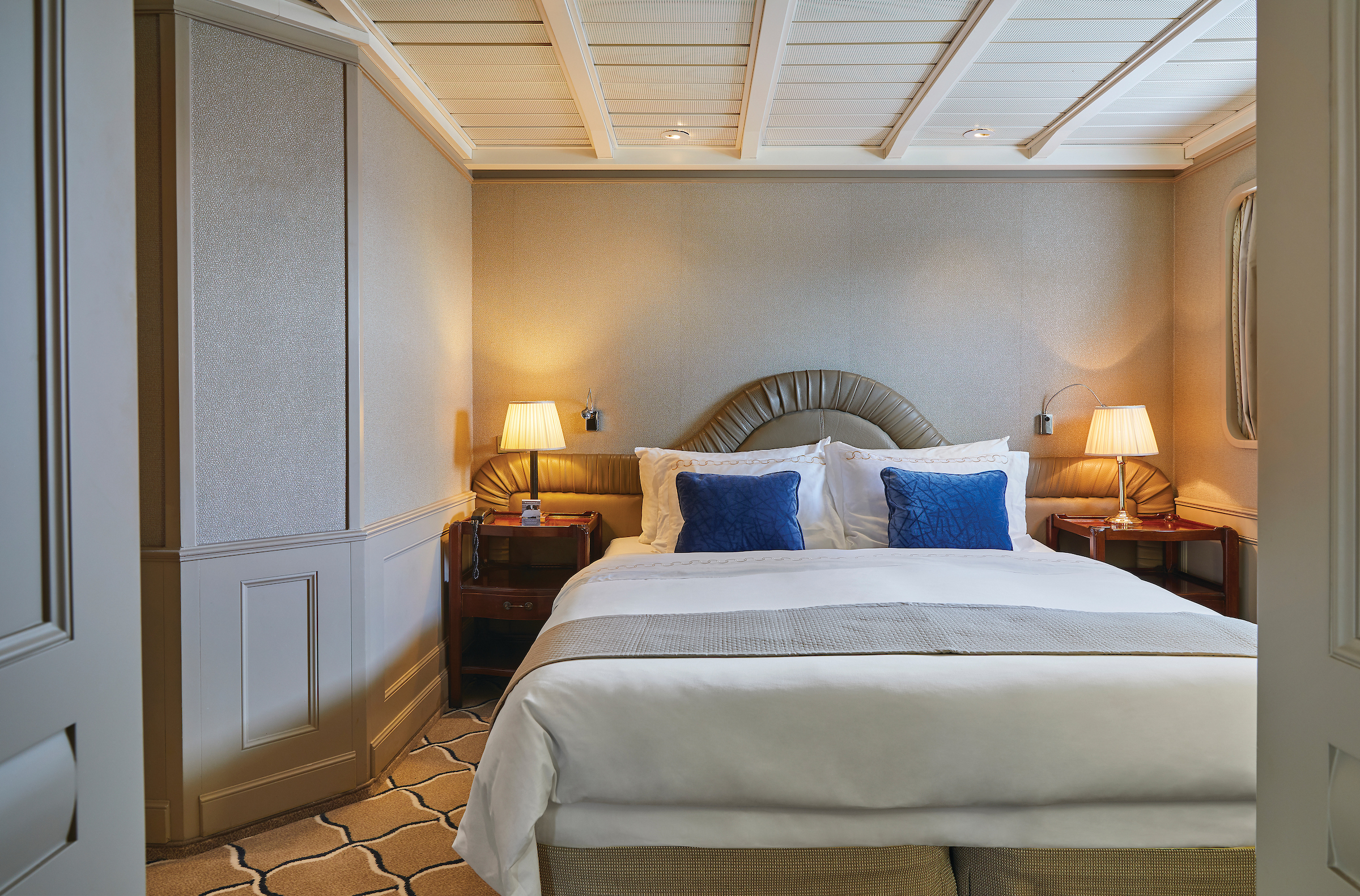
Royal Suite
Stately. Commanding and majestic. Perfect for entertaining. The Royal suite lives up to its name. Enough living space to roam. The pinnacle of good living. Available as a one-bedroom configuration or as two bedroom by adjoining with a Veranda Suite.
One bedroom: 69 sq.m. including veranda
Two bedroom: 96 sq.m. including veranda
Images and suite plans are intended as a general reference. Features, materials, finishes and layout maybe different than shown.
Please note that the 3rd guest will sleep on a comfortable sofa bed in the reception area of the suite.
Essentials
- Deck(s): 6
- Section: Forward
Characteristics
- Veranda
- Separate dining area
- Living room with sitting area
- Standard vanity
- Walk-in shower
- Whirlpool bath
- Walk-in wardrobe with personal safe
Furniture
- Queen size bed
- Writing desk
- Vanity table
- Luxury bed mattresses
Media & Communication
- Unlimited Premium Wi-Fi
- 2 large flat screen TVs with Interactive Media Library
- Sound system with bluetooth connectivity
- Direct dial telephone
- Wall mounted USB-C mobile device chargers
- Dual voltage 110/220 outlets
Onboard Services
- Butler service
- Complimentary laundry, pressing & wet cleaning
- Daily canape service, Welcome chocolate, Welcome fruit stand
- Dinner for two in La Dame, one evening per voyage,
- Two hours of worldwide phone use, per voyage segment
- Champagne on arrival
Amenities
- Espresso machine
- Pillow menu
- Refrigerator and bar setup stocked with your preferences
- Plush bathrobe
- Luxury bath amenities
- Umbrella
- Hair Dryer
- Slippers

Silver Suite
Stylish and sophisticated. Larger verandas. Perfection in design for comfortable living.
For those wanting more space, Silver Suites are ideal. Stylish and sophisticated. Separate dining and living rooms. Larger verandas. Situated midship on the Silver Wind. Perfection in design for comfortable living. Silver Suites accommodate three guests.
One bedroom: 48 sq.m. including veranda
Images and suite plans are intended as a general reference. Features, materials, finishes and layout maybe different than shown.
Please note that the 3rd guest will sleep on a comfortable sofa bed in the reception area of the suite.
Essentials
- Deck(s): 5, 6, 7
- Section: Mid-Ship
Characteristics
- Veranda
- Separate dining area
- Living room with sitting area
- Standard vanity
- Full-size bath
- Walk-in wardrobe with personal safe
Furniture
- Queen size bed
- Writing desk
- Vanity table
- Luxury bed mattresses
Media & Communication
- Unlimited Premium Wi-Fi
- 2 large flat screen TVs with Interactive Media Library
- Sound system with bluetooth connectivity
- Direct dial telephone
- Wall mounted USB-C mobile device chargers
- Dual voltage 110/220 outlets
Onboard Services
- Butler service
- Complimentary laundry, pressing & wet cleaning
- Daily canape service, Welcome chocolate, Welcome fruit stand
- Champagne on arrival
Amenities
- Espresso machine
- Pillow menu
- Refrigerator and bar setup stocked with your preferences
- Plush bathrobe
- Luxury bath amenities
- Umbrella
- Hair Dryer
- Slippers

Medallion Suite
Teak-style balcony with floor-to-ceiling glass doors. Relaxing living room space with seating area.
A mark of distinction. Sumptuous. Spacious. Rich textures and panoramic views surround you with distinguished luxury. The perfect summary of The Medallion Suite offered by the world’s best cruise line.
One bedroom: 41 sq.m. including veranda
Suite 741: 667 sq.ft / 62 sq.m. with French balcony, separate dining area and full-size bath.
Suites 801-804 only: with Veranda
Images and suite plans are intended as a general reference. Features, materials, finishes and layout maybe different than shown.
Please note that the 3rd guest will sleep on a comfortable sofa bed in the reception area of the suite.
Essentials
- Deck(s): 7, 8
- Section: Mid-Ship
Characteristics
- Veranda
- Separate dining area
- Living room with sitting area
- Standard vanity
- Walk-in shower
- Walk-in wardrobe with personal safe
Furniture
- Queen size bed
- Writing desk
- Vanity table
- Luxury bed mattresses
Media & Communication
- Unlimited Premium Wi-Fi
- 2 large flat screen TVs with Interactive Media Library
- Sound system with bluetooth connectivity
- Direct dial telephone
- Wall mounted USB-C mobile device chargers
- Dual voltage 110/220 outlets
Onboard Services
- Butler service
- Complimentary laundry, pressing & wet cleaning
- Daily canape service, Welcome chocolate, Welcome fruit stand
- Champagne on arrival
Amenities
- Espresso machine
- Pillow menu
- Refrigerator and bar setup stocked with your preferences
- Plush bathrobe
- Luxury bath amenities
- Umbrella
- Hair Dryer
- Slippers
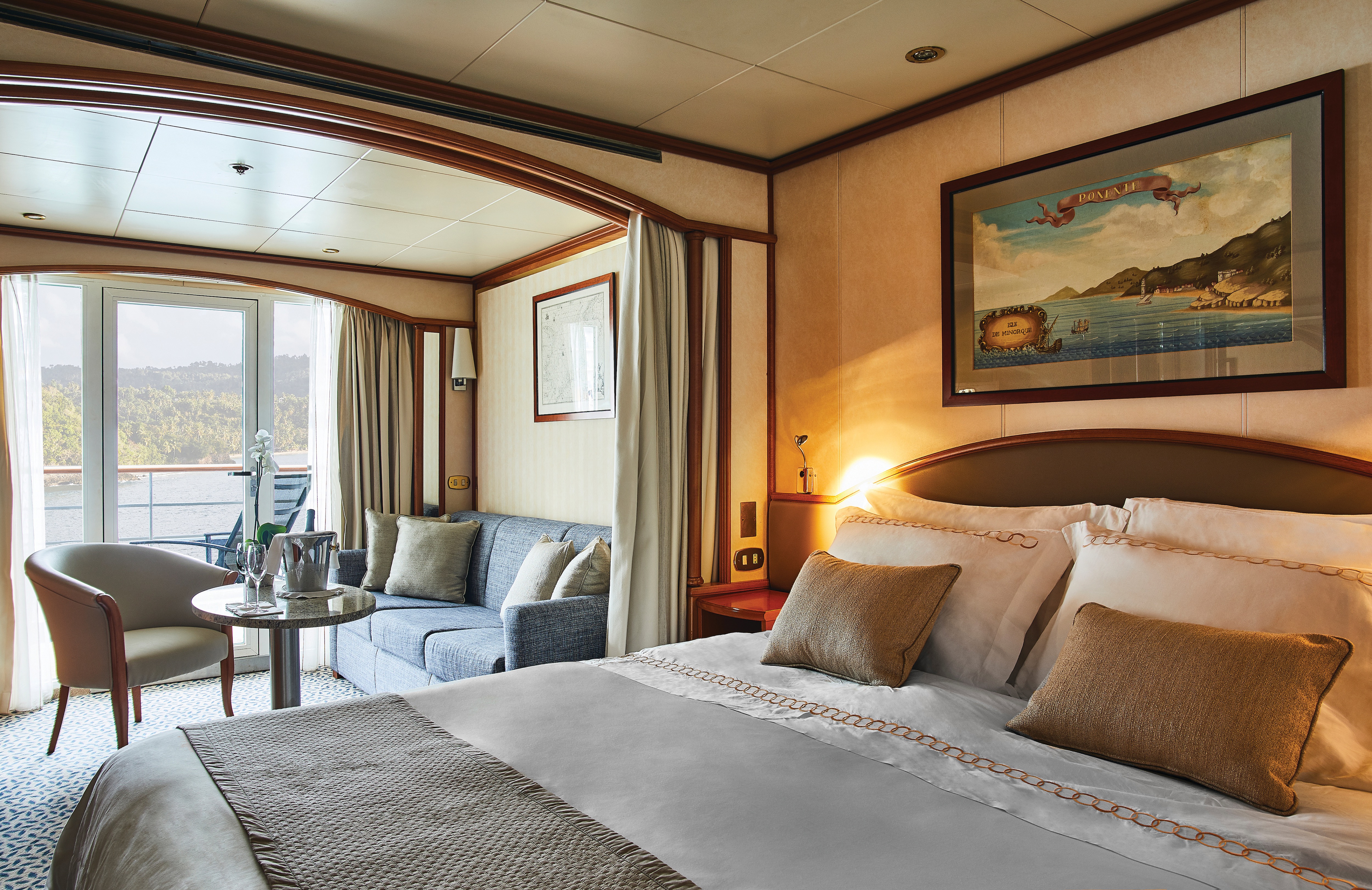
Deluxe Veranda Suite
Spacious and welcoming. A furnished private teak veranda. A preferred central location
The Deluxe Veranda Suite offers unbeatable views. A Silversea signature. Spacious and welcoming. Floor-to-ceiling glass doors open onto a furnished private teak veranda. Each spectacular sunset feels like it is yours alone. The Deluxe Veranda Suite offers a preferred central location with identical accommodation to a Veranda Suite. No top cruise line would be complete without such a luxury.
One bedroom: 27 sq.m. including veranda
Images and suite plans are intended as a general reference. Features, materials, finishes and layout maybe different than shown.
Please note that the 3rd guest will sleep on a comfortable sofa bed in the reception area of the suite.
Essentials
- Deck(s): 5, 6, 7
- Section: Mid-Ship
Characteristics
- Veranda
- Sitting area
- Standard vanity
- Walk-in shower
- Walk-in wardrobe with personal safe
Furniture
- Queen size bed
- Writing desk
- Luxury bed mattresses
Media & Communication
- Unlimited Standard Wi-Fi
- 1 large flat screen TV with Interactive Media Library
- Direct dial telephone
- Wall mounted USB-C mobile device chargers
- Dual voltage 110/220 outlets
Onboard Services
- Butler service
- Champagne on arrival
Amenities
- Pillow menu
- Refrigerator and bar setup stocked with your preferences
- Plush bathrobe
- Luxury bath amenities
- Umbrella
- Hair Dryer
- Slippers
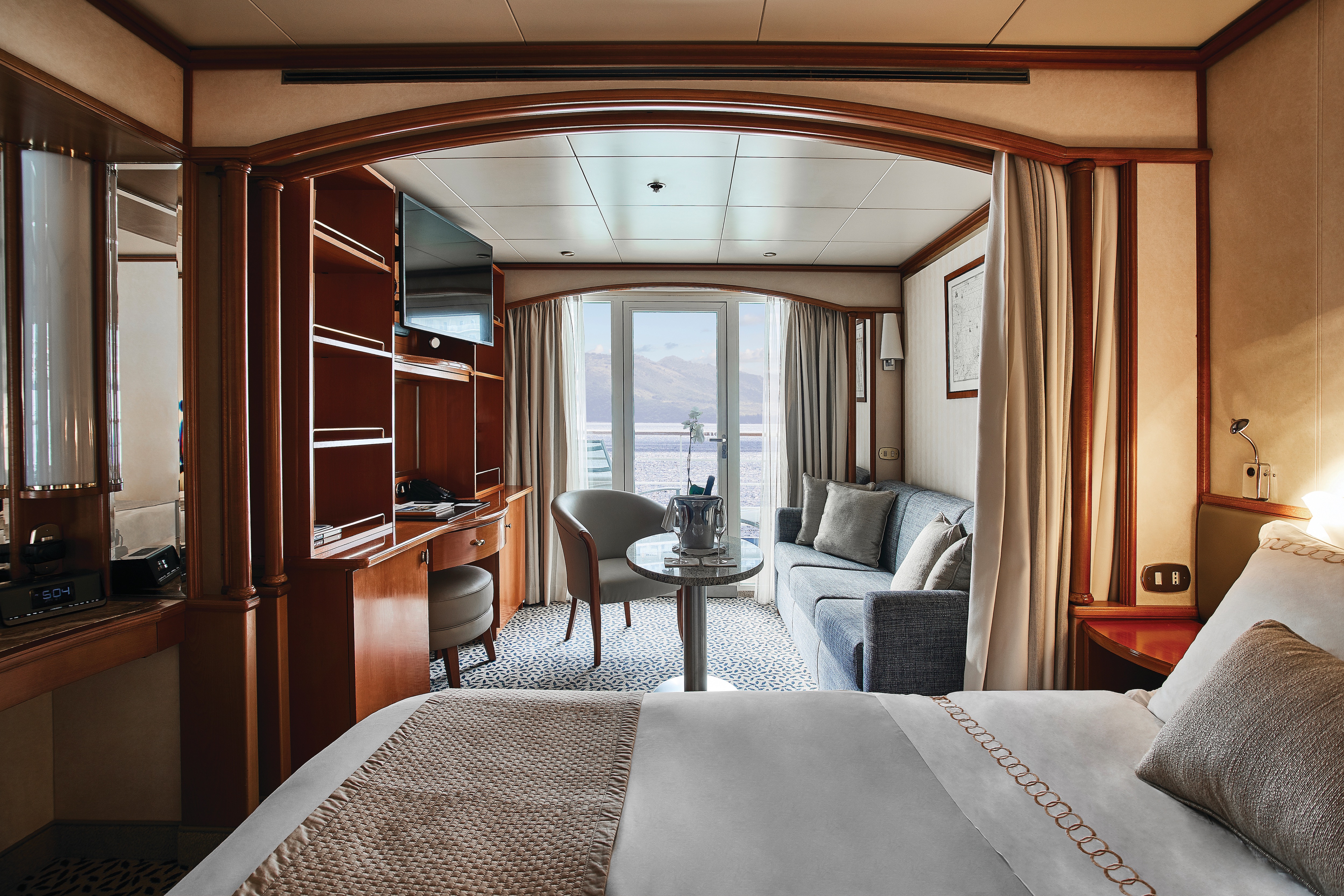
Classic Veranda Suite
Classic Veranda Suite rooms are spacious with beautiful sunset views aboard Silver Wind, making Silversea a top cruise line.
A Silversea signature, the Classic Veranda Suite is spacious and welcoming. Veranda suites offer floor-to-ceiling glass doors which open onto a furnished private teak veranda. Each spectacular sunset feels like it is yours alone. Some Classic Veranda Suites accommodate three guests. A must for the world’s best cruise line.
One bedroom: 27 sq.m. including veranda
Images and suite plans are intended as a general reference. Features, materials, finishes and layout maybe different than shown.
Please note that the 3rd guest will sleep on a comfortable sofa bed in the reception area of the suite.
Essentials
- Deck(s): 5, 6, 7
- Section: Forward
Characteristics
- Veranda
- Sitting area
- Standard vanity
- Walk-in shower
- Walk-in wardrobe with personal safe
Furniture
- Queen size bed
- Writing desk
- Luxury bed mattresses
Media & Communication
- Unlimited Standard Wi-Fi
- 1 large flat screen TV with Interactive Media Library
- Direct dial telephone
- Wall mounted USB-C mobile device chargers
- Dual voltage 110/220 outlets
Onboard Services
- Butler service
- Champagne on arrival
Amenities
- Pillow menu
- Refrigerator and bar setup stocked with your preferences
- Plush bathrobe
- Luxury bath amenities
- Umbrella
- Hair Dryer
- Slippers
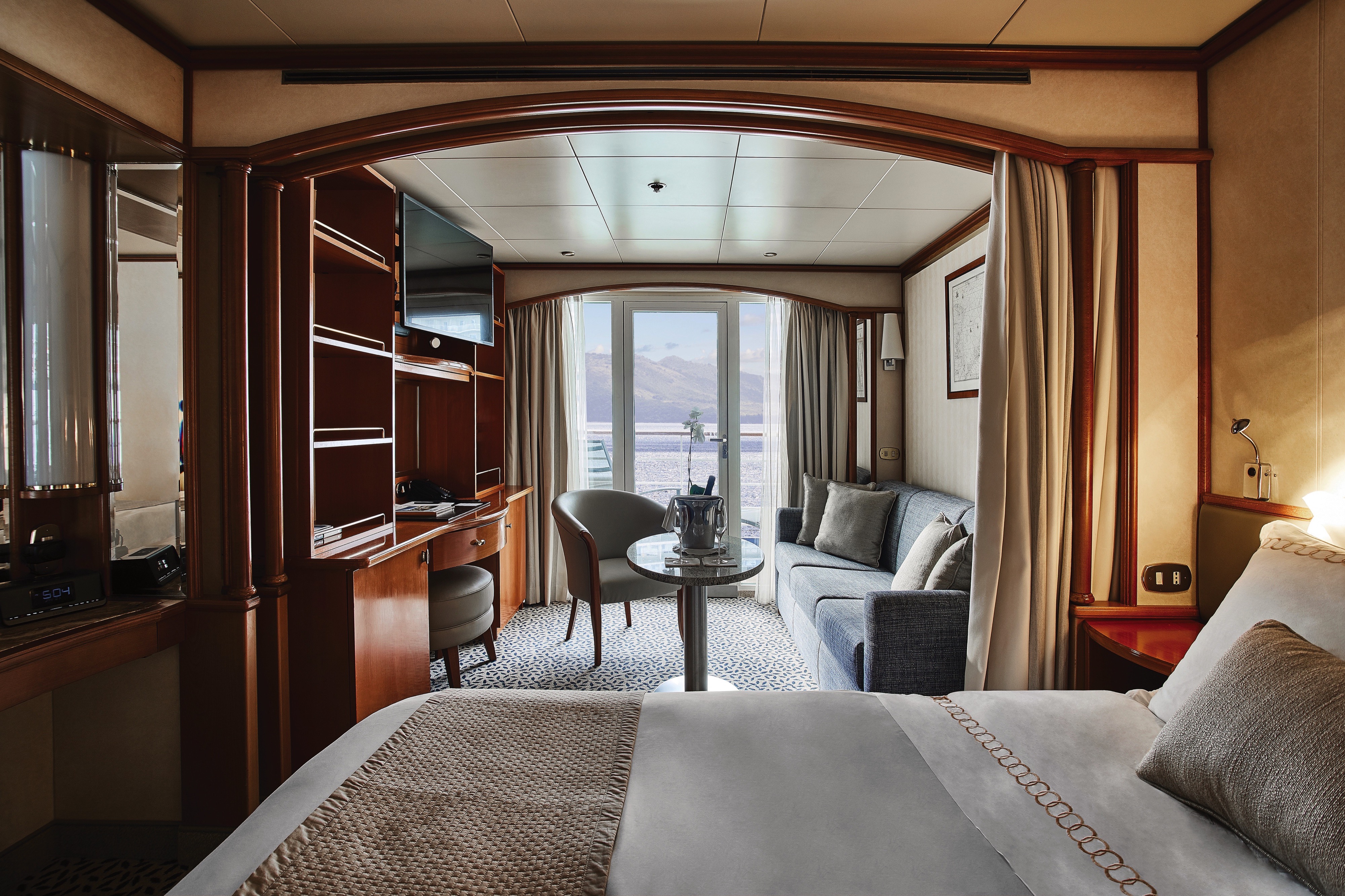
Vista Suite
A quiet sanctuary to escape to on your cruise. The seating area has plenty of room to relax. Large picture windows frame panoramic ocean views. The perfect backdrop for breakfast in bed.
One bedroom: 22 sq.m.
Suite 738: 325 sq.ft. / 30 sq.m.
Wheelchair accessible suites: 445 and 447
Images and suite plans are intended as a general reference. Features, materials, finishes and layout maybe different than shown.
Please note that the 3rd guest will sleep on a comfortable sofa bed in the reception area of the suite.
Essentials
- Deck(s): 4, 7
- Section: Aft, Forward
Characteristics
- Window
- Sitting area
- Standard vanity
- Walk-in shower
- Walk-in wardrobe with personal safe
Furniture
- Queen size bed
- Writing desk
- Luxury bed mattresses
Media & Communication
- Unlimited Standard Wi-Fi
- 1 large flat screen TV with Interactive Media Library
- Direct dial telephone
- Wall mounted USB-C mobile device chargers
- Dual voltage 110/220 outlets
Onboard Services
- Butler service
- Champagne on arrival
Amenities
- Pillow menu
- Refrigerator and bar setup stocked with your preferences
- Plush bathrobe
- Luxury bath amenities
- Umbrella
- Hair Dryer
- Slippers
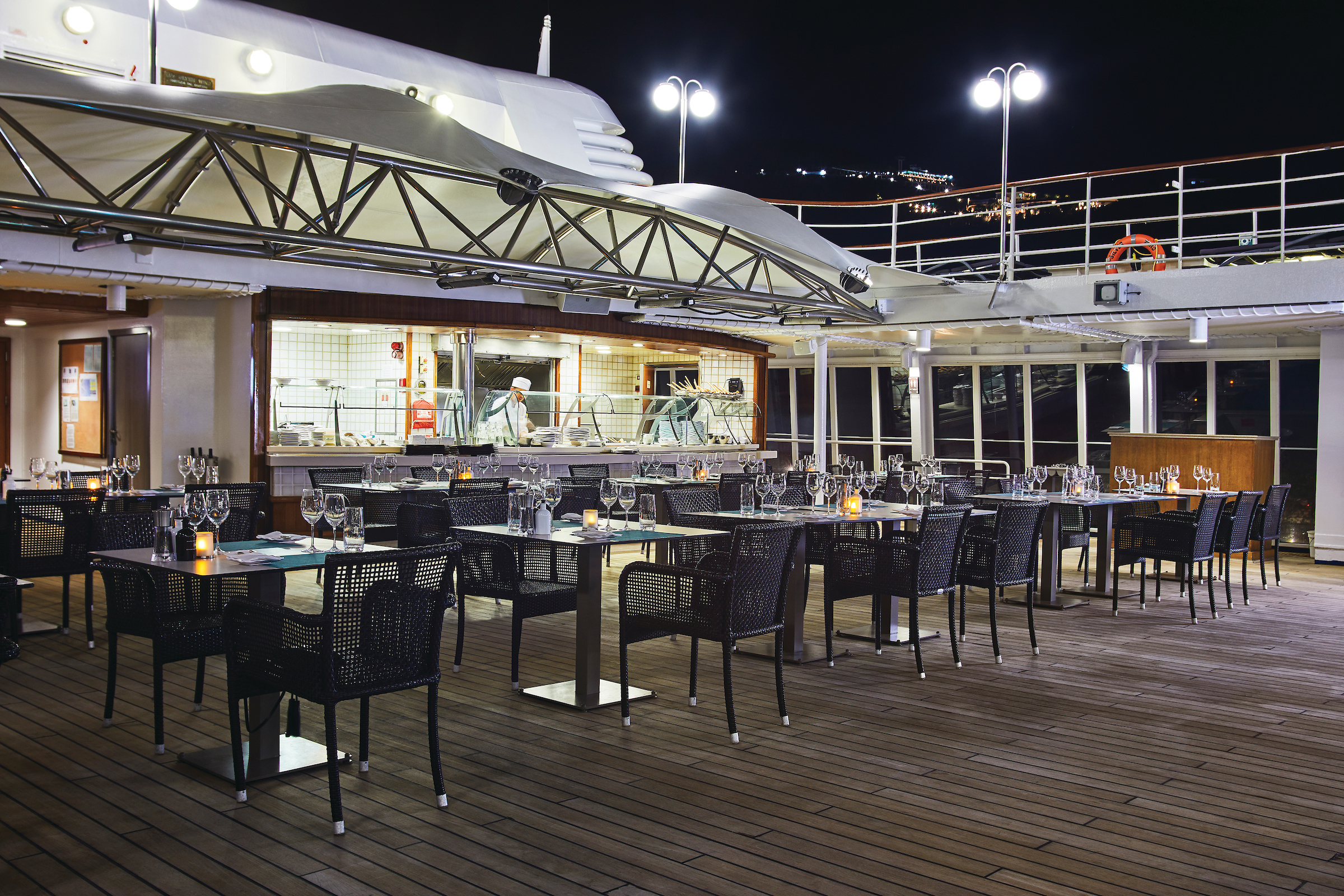
The Grill
Soft breezes and ocean views beckon at the Grill, especially as the sun goes down when cruise guests gather for cocktails at the outdoor bar and talk about the day’s events.
Silversea’s much-loved casual dining restaurant serves a delectable range of burgers and salads by day and turns into our famous Hot Rocks table BBQ concept by night. The Grill is quite simply the best place to eat between sea and sky. If you like flavoursome meals cooked to perfection, a casual, laid-back atmosphere, and OMG views, then The Grill is the answer to your prayers.
Dress code: Casual
Casual wear consists of pants, blouses or casual dresses for women; open-neck shirts and slacks for men are appropriate.
Images and suite plans are intended as a general reference. Features, materials, finishes and layout may be different than shown.
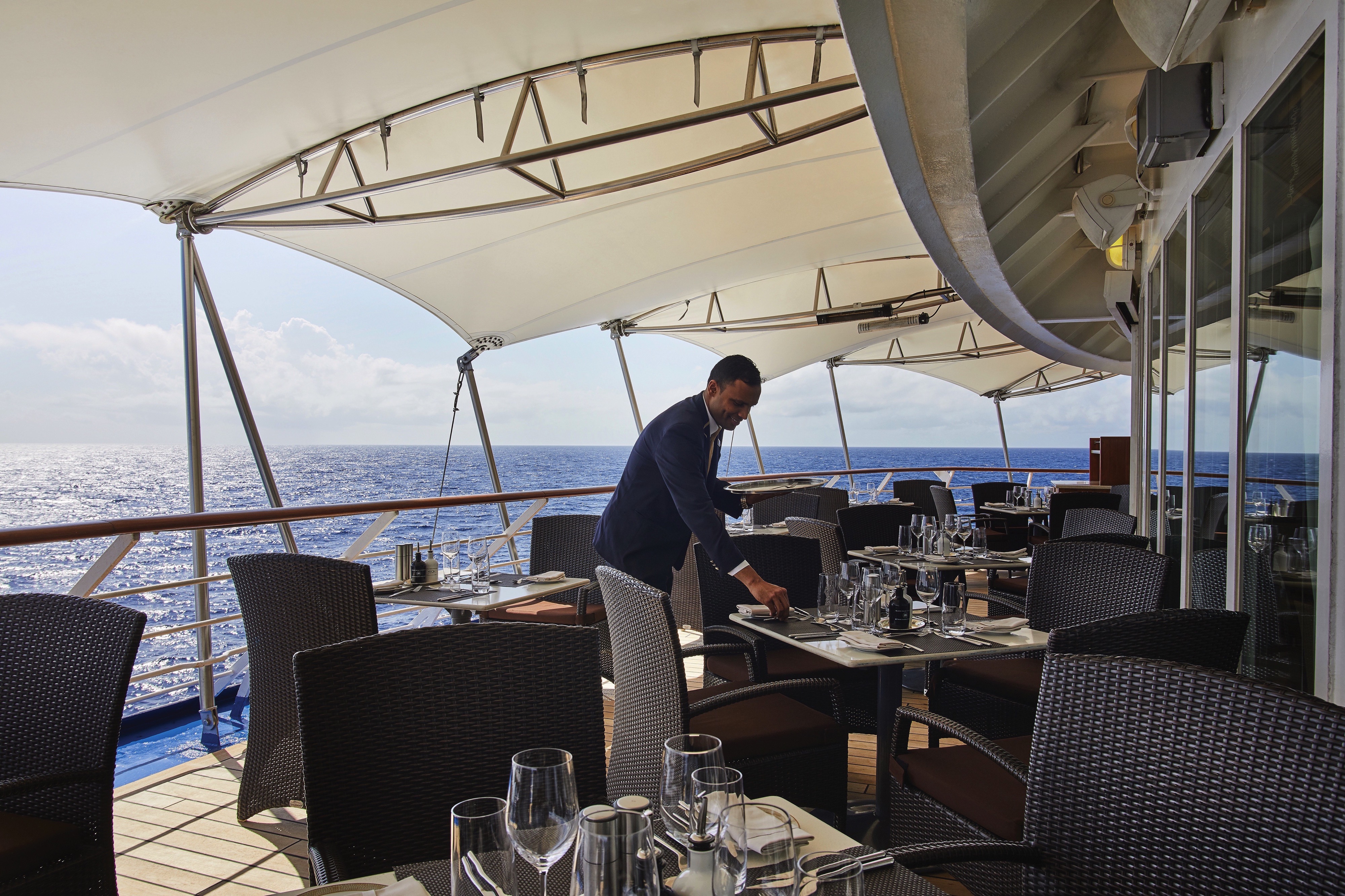
La Terrazza
Authentic Italian recipes and the freshest, sustainable ingredients come together in this restaurant at sea.
On board this luxury cruise ship, a divine selection of Italy’s best cuisine is served à la carte in La Terrazza. Authentic recipes and the freshest ingredients come together with flair and passion—a flavorful expression of Silversea’s distinctive Italian heritage. La Terrazza uses buffalo mozzarella from Naples, organic balsamic vinegar and olive oil from Umbria, and air-dried ham from Parma. The Emilia-Romagna region also produces Silversea’s 24-month aged Parmigiano Reggiano, while the pasta is made fresh daily on board the Silver Wind. La Terrazza is open for casual, buffet-style breakfast and lunch with indoor or alfresco dining on the outdoor terrace of this luxury cruise ship. During the evening, La Terrazza transforms into an à la carte traditional Italian restaurant.
Open-seating for breakfast and lunch.
Reservations recommended for dinner.
Images and suite plans are intended as a general reference. Features, materials, finishes and layout may be different than shown.

The Restaurant
Enjoy Continental and regional specialities, as well as sweeping ocean views in our main dining room.
Sparkling with silver, crystal and candlelight, this luxury cruise ship’s main dining room serves contemporary, international cuisine with the sophisticated elegance and impeccable service you might expect as part of your prestige travel. Menus feature regional specialties unique to the voyage destination. For example, roasted Chilean sea bass while cruising the Chilean fjords and Indian chicken korma en route to Mumbai. The Restaurant on board this luxury cruise ship offers open-seating dining, which means there are no assigned times and no assigned tables. You are free to dine when, where and with whom you please.
Images and suite plans are intended as a general reference. Features, materials, finishes and layout may be different than shown.
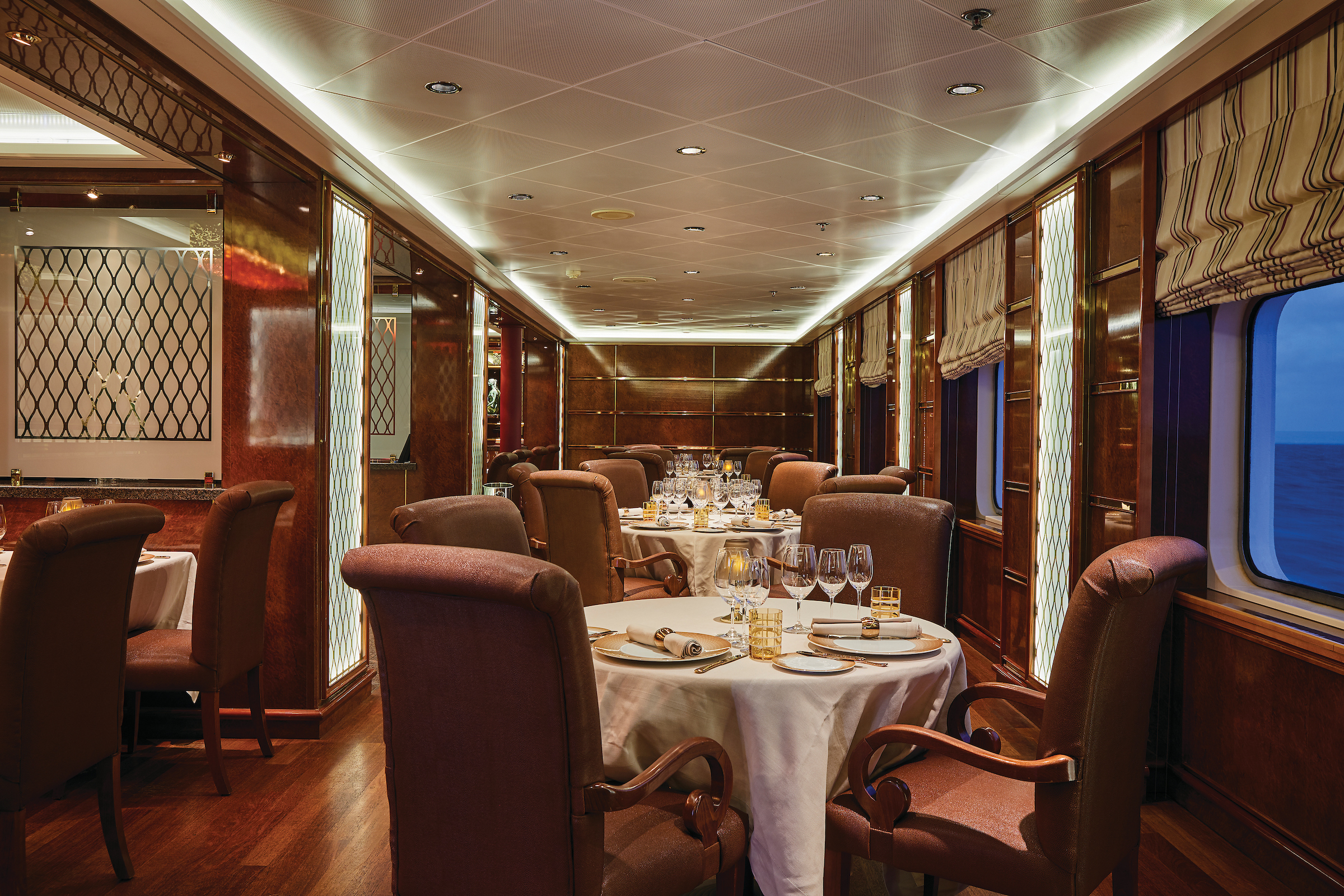
La Dame
La Dame features a menu of seasonally inspired dishes prepared with the freshest locally sourced ingredients.
La Dame can be found aboard Silversea luxury cruise ships. Indulge in an evening where fine wines are complemented by a special set menu of regionally-inspired dishes in an intimate, elegant setting. An extraordinary six-course experience celebrating the world’s most distinguished wine regions aboard your luxury cruise ship.
Per guest reservation fee of US$60. Please visit My Silversea to make your reservations.
Reservations required for dinner.
Images and suite plans are intended as a general reference. Features, materials, finishes and layout may be different than shown.
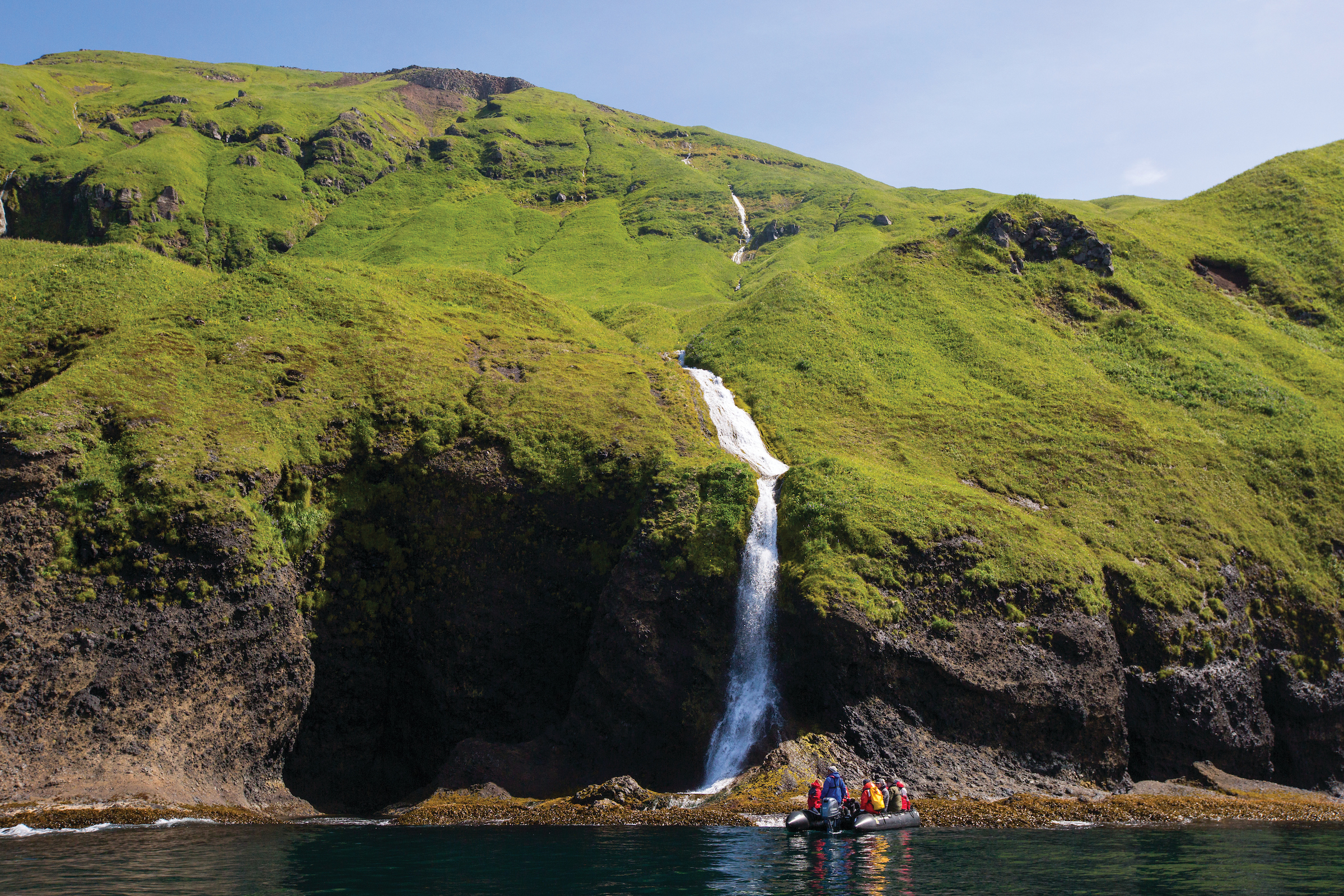
Shore Excursions
Highlight Experiences
Seamless tours of iconic sites
Explore iconic landmarks and cultural treasures with our Highlight Experiences, half or full-day adventures led by expert guides. Enjoy seamless, hassle-free journeys to must- see attractions — perfect for guests seeking a convenient, turnkey experience.
Signature Experiences
Smaller tours, crafted by Silversea
These immersive Signature Experiences offer privileged access and personalized interactions with local experts. These experiences are perfect for those seeking meaningful, social exploration who want to connect with destinations through authentic dining and slow travel.
Private Experiences
Exclusive tours for your group
Create your own exclusive adventure with a dedicated vehicle, driver, and guide. Explore at your pace, linger, or spontaneously discover new sites. Available at most ports for half- or full-day bookings, Private Experiences are ideal for families seeking privacy and flexibility.
Custom Experiences
Tailor-made tours designed for you
Enjoy personalized Custom Experiences tailored to your interests, with exclusive access and specialized guides. Our team handles every detail, ensuring unforgettable moments that exceed your expectations—crafted entirely around your pace and preferences.
Overland Experiences
Mid-cruise, inland tours
Venture inland on two- to three-day journeys to iconic sites like the Taj Mahal or Angkor Wat. Vith flights, stays, and guided access included, these immersive journeys offer rare experiences beyond the coast — all with the signature Silversea service.
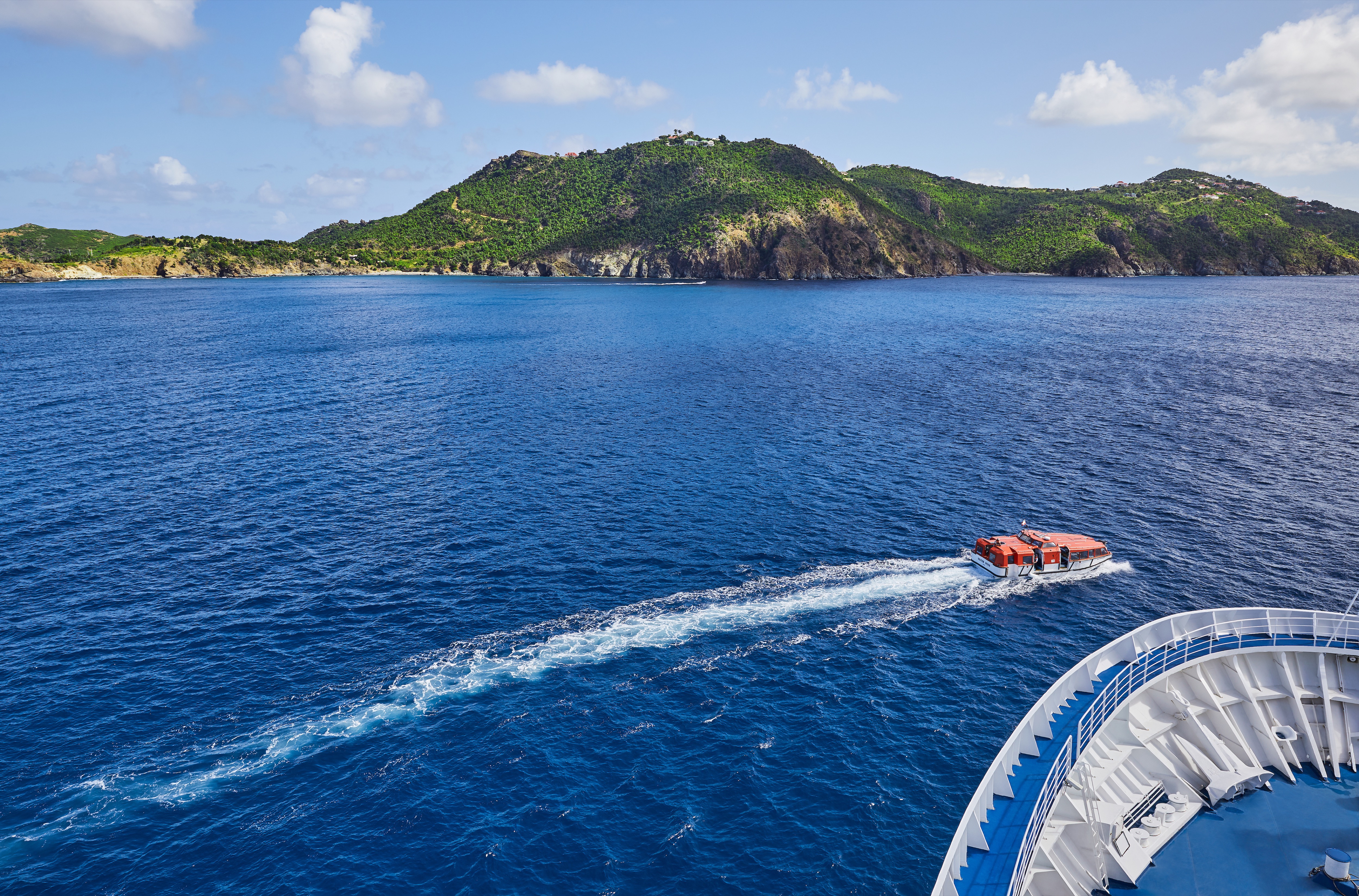
Mid-Voyage Adventures
Multiple days at sea mean plenty of R & R for some, but others prefer to drink in all there is to offer on land. Our Mid-Cruise Land Adventures allow you to take full advantage of your time with us without missing a single thing! These short escapades offer an array of adventures, break up your sea days and allow for deeper exploration beyond the coast.

Silver Shore Concierge
Let Silversea customise a special event or excursion exclusively for you. Expert Shore Excursion professionals are available to assist with all your shorex questions. Make an appointment and gain insider access to knowledgeable suggestions, personalised planning and hassle-free coordination of all private, independent touring, including area highlights, flightseeing, water sports, and much more. Take advantage of this service either in advance of your voyage by email at shoreconcierge@silversea.com or on board by visiting the Silvershore® Concierge desk. Have the Silver Shore Concierge create your tailor-made tour, or be whisked away by private car for a day — the pace and agenda are up to you.

Boutique
There is a wealth of luxury shopping experiences aboard all Silversea ships, featuring the most distinctive and appealing brands from across the globe.
Exceptional shopping experiences do not end in the cosmopolitan cities we visit. Silversea’s striking new shipboard boutiques, reimagined and redesigned, are stunning modern design spaces befitting the finest creations from legendary designers. Carefully selected partners available in Silversea’s duty-free boutiques offer our guests a carefully curated selection of cutting-edge fashions, jewellery, accessories, fine perfumes, cosmetics and Silversea Logo collection all at duty-free prices.
Images and suite plans are intended as a general reference. Features, materials, finishes and layout may be different than shown.
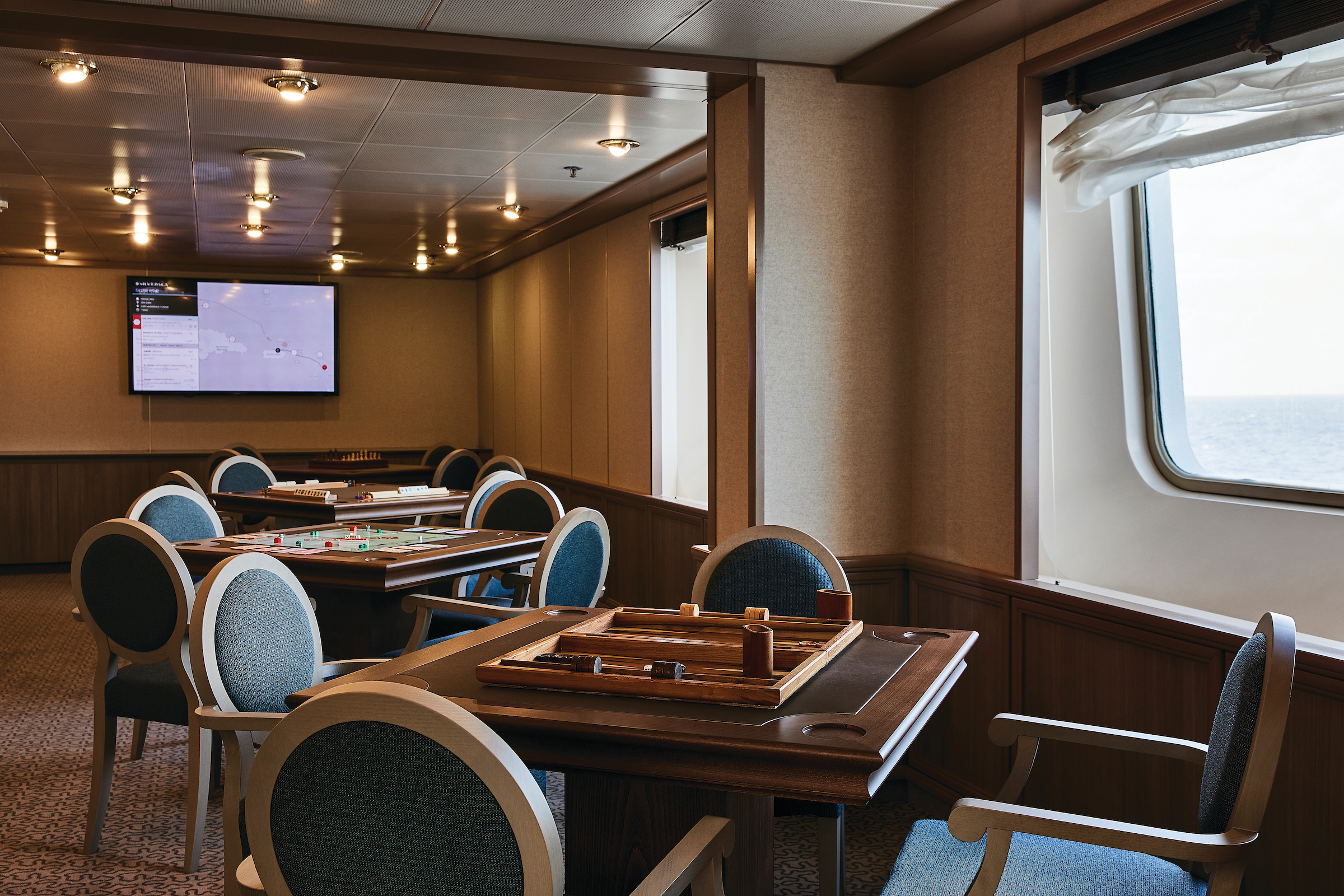
Conference Room
The Card Room on board this luxury cruise ship is where Bridge games and tournaments take place most days. On days at sea, newcomers to the game can learn how to play. Should your group require a conference or meeting space, Silversea is pleased to provide a tailor-made experience. Audio-visual equipment is available and complimentary.

Connoisseur's Corner
If you appreciate good cognac or premium cigars, be sure to visit the Connoisseur’s Corner to see the ship’s exceptional selection.
The Connoisseur’s Corner on board the Silver Wind offers exceptional cognacs along with a premium selection of cigars for purchase to enjoy during your stay on the ship.
Images and suite plans are intended as a general reference. Features, materials, finishes and layout maybe different than shown.
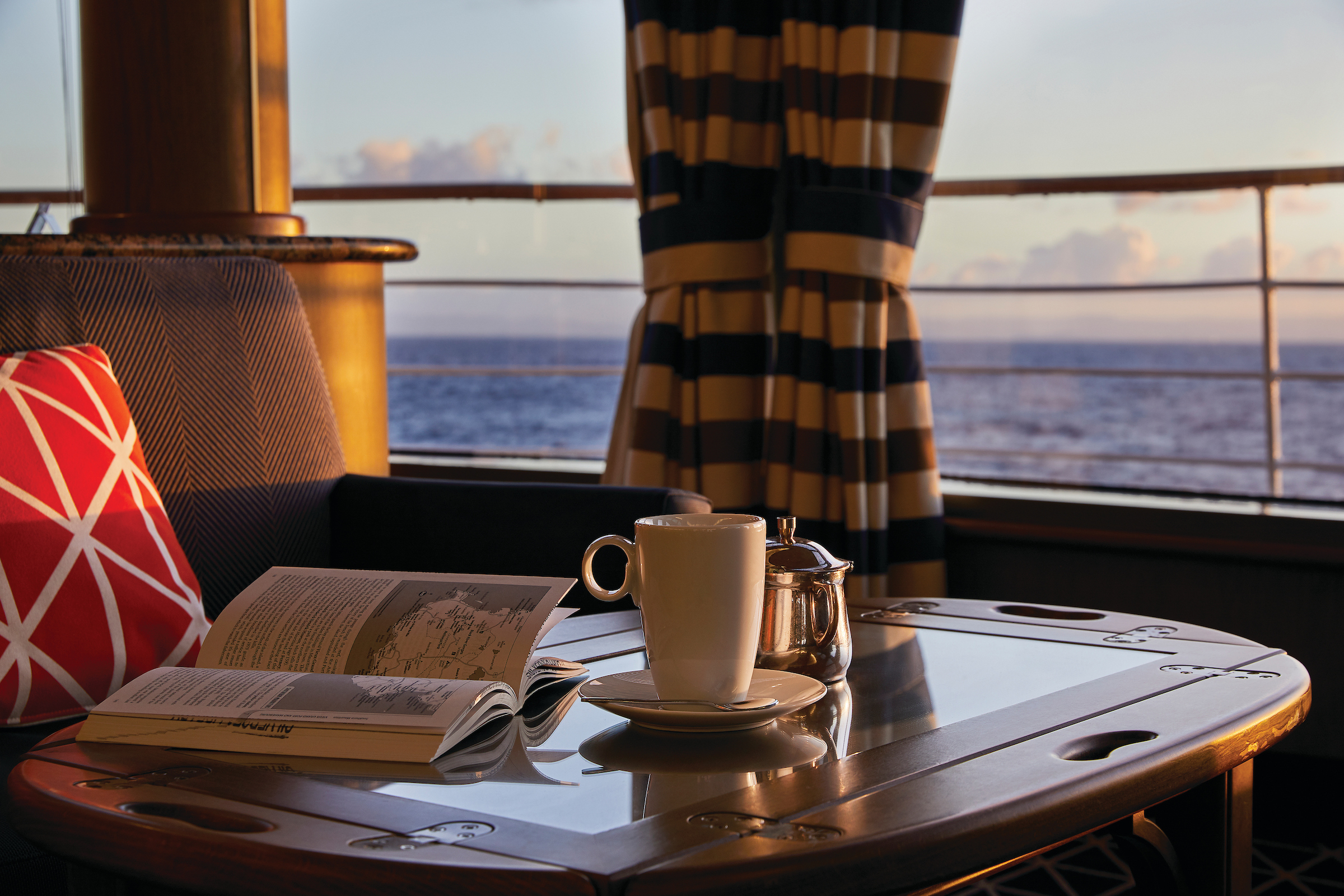
Observation Library
The Observation Library boasts exceptional views overlooking the ocean as it stretches out below you while you enjoy your cruise.
Set on the highest level at the very top of the ship, this is a quiet space for reading and reflection while being dazzled by the undulating seascapes that are part of life on board.
Images and suite plans are intended as a general reference. Features, materials, finishes and layout may be different than shown.
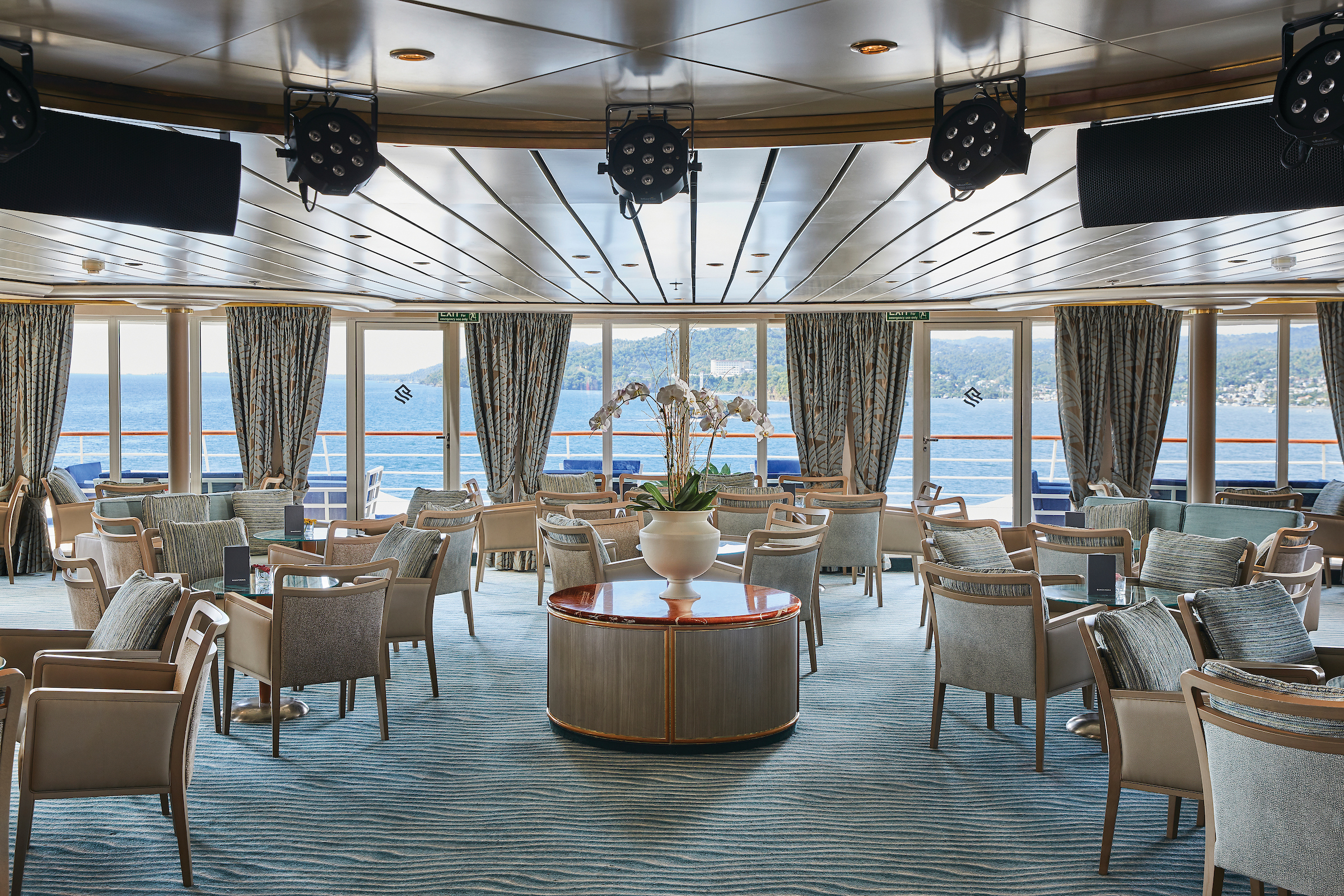
Panorama Lounge
Relax and unwind in the Panorama Lounge, a sophisticated yet amicable space offering beautiful ocean views as you enjoy your cruise.
The Silver Wind’s Panorama Lounge is specially designed to provide an uninterrupted view of the day’s destination from the comfort of the luxury cruise ship’s interior. This is an ideal place to unwind on your cruise, enjoy afternoon tea, listen to the pianist and watch the setting sun. The drinks are complimentary, and the music live and inviting. Enjoy dancing to a range of musical styles for every taste, from the classics to the latest club mixes.
Images and suite plans are intended as a general reference. Features, materials, finishes and layout may be different than shown.
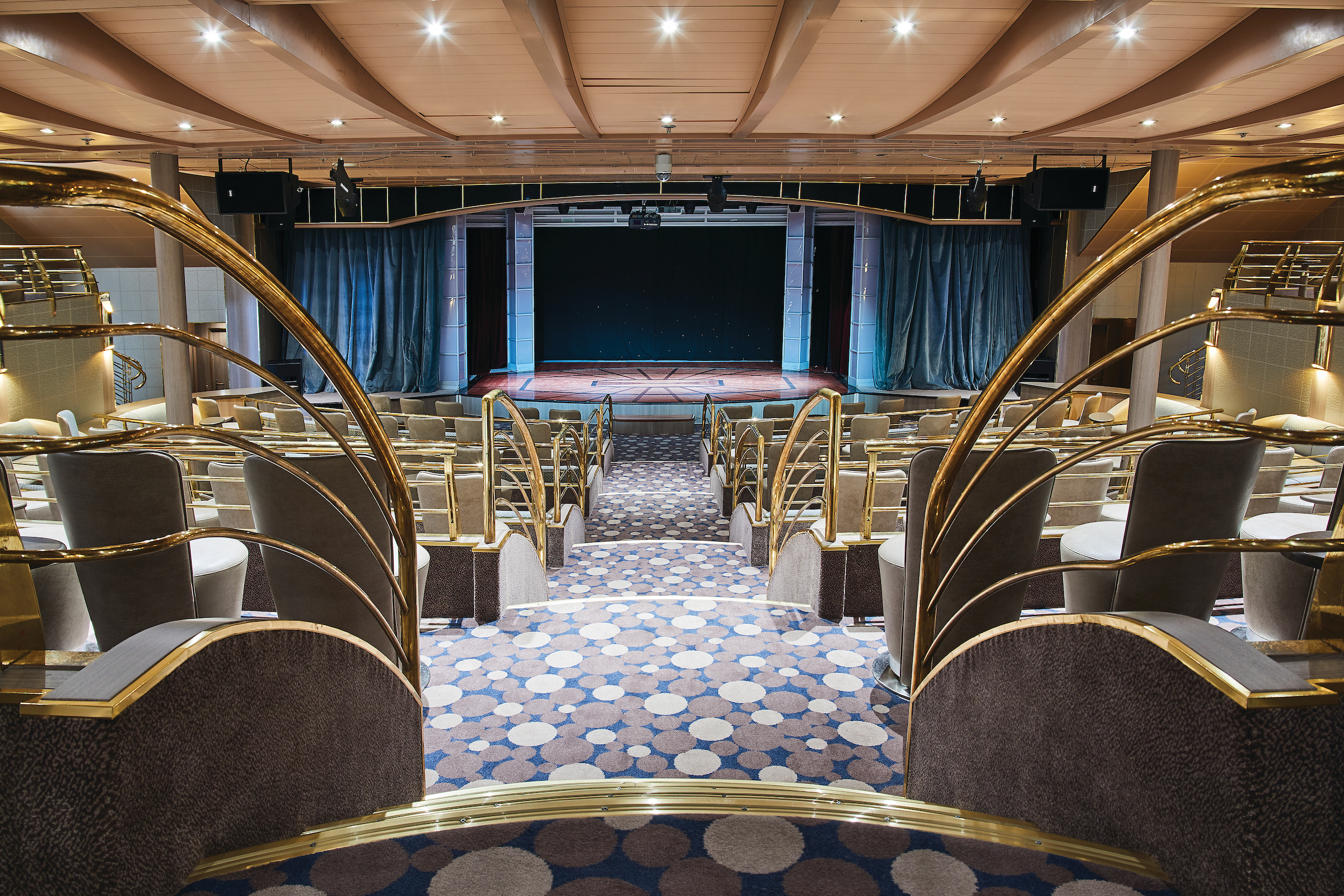
The Show Lounge
Enjoy a broad spectrum of entertainment from full-scale production shows and classical soloists, to cultural entertainment and feature films.
Enjoy a bit of culture on your luxury cruise. Every seat in this multitiered venue features a clear view of the stage. Enjoy a broad spectrum of entertainment—from full-scale production shows and classical soloists, to cultural entertainment and feature films. Throughout your voyage, this luxury cruise ship’s The Show Lounge also presents port talks, enrichment lectures and a variety of special events.
Images and suite plans are intended as a general reference. Features, materials, finishes and layout may be different than shown.
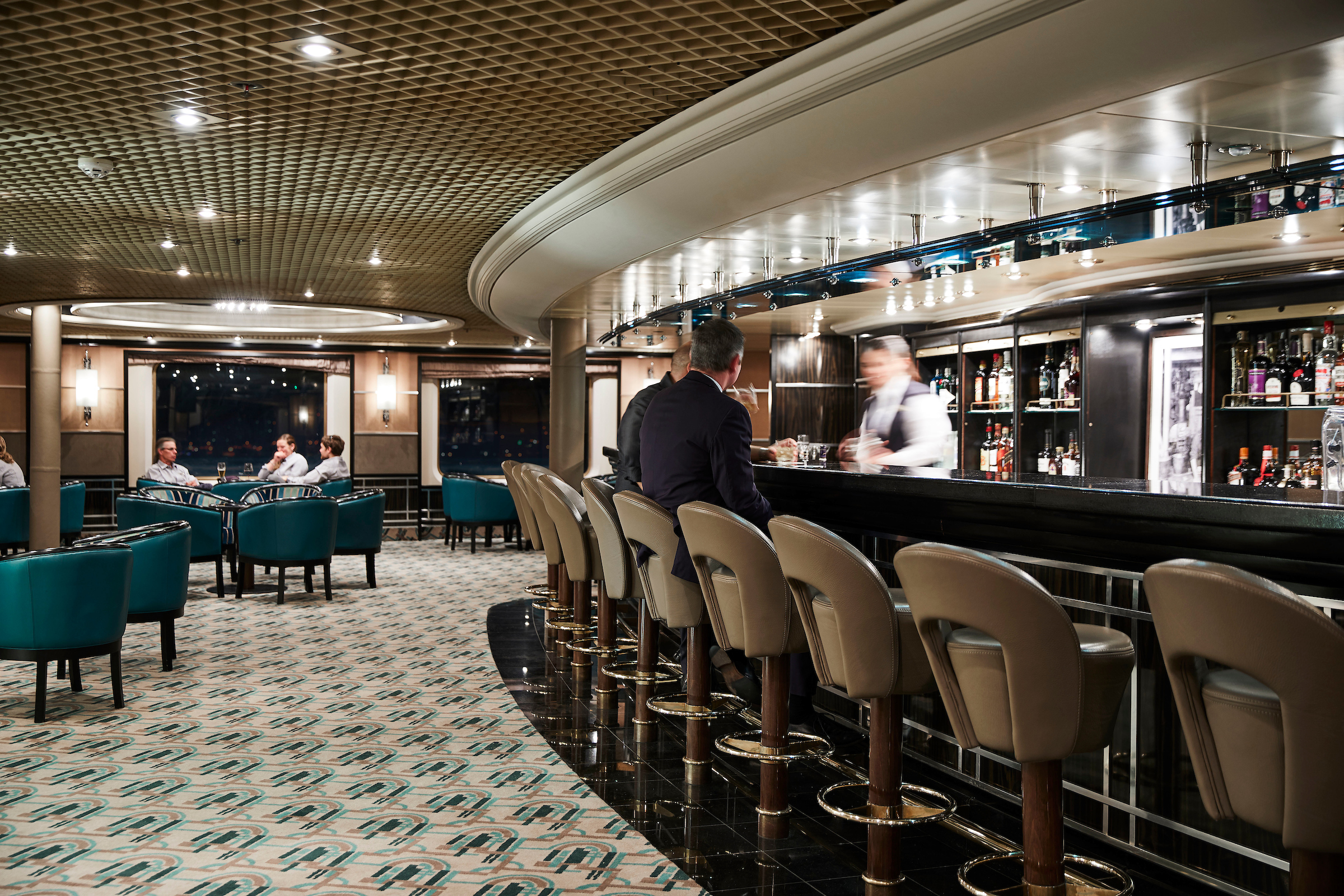
Dolce Vita
Dolce Vita is the gathering place for our savvy travellers of the world, a place where guests mingle and exchange stories and where new faces become lifelong friends.
Our main bar has been newly reimagined for Silver Dawn! Dolce Vita has of course kept her legendary charm, inspired cocktails, stylish décor and comfortable seating, but a central bar now means the warm ambience is better than ever! Oozing Italian glamour, Dolce Vita is a relaxed, refined bar with a nightly piano player playing all your favorite tunes. Perfect for a pre-dinner aperitif, or a post-dinner cocktail, Dolce Vita is truly the beating heart of social life on board.
Images and suite plans are intended as a general reference. Features, materials, finishes and layout may be different than shown.

Reception
Be sure to visit the Reception area, where our experts can provide invaluable information to help you get the most out of your cruise.
The Silver Wind’s central lobby area welcomes guests to speak with a Guest Relations specialist should they have a question or require any help. Assistance is available 24 hours a day; they will be able to help with any aspect of your cruise. For guests wishing to make shoreside arrangements, the Silver Shore Concierge is available to assist with knowledgeable suggestions and the personalized coordination of all private, independent touring including sightseeing, water sports, golf and more. The Cruise Consultant can prove indispensable when planning your next Silversea voyage, or should you wish to extend your current voyage for a day, a week or a month. Like having your own personal onboard Silversea professional, the Cruise Consultant will help you select the perfect voyage, reserve your preferred suite and provide immediate confirmation.
Images and suite plans are intended as a general reference. Features, materials, finishes and layout may be different than shown.
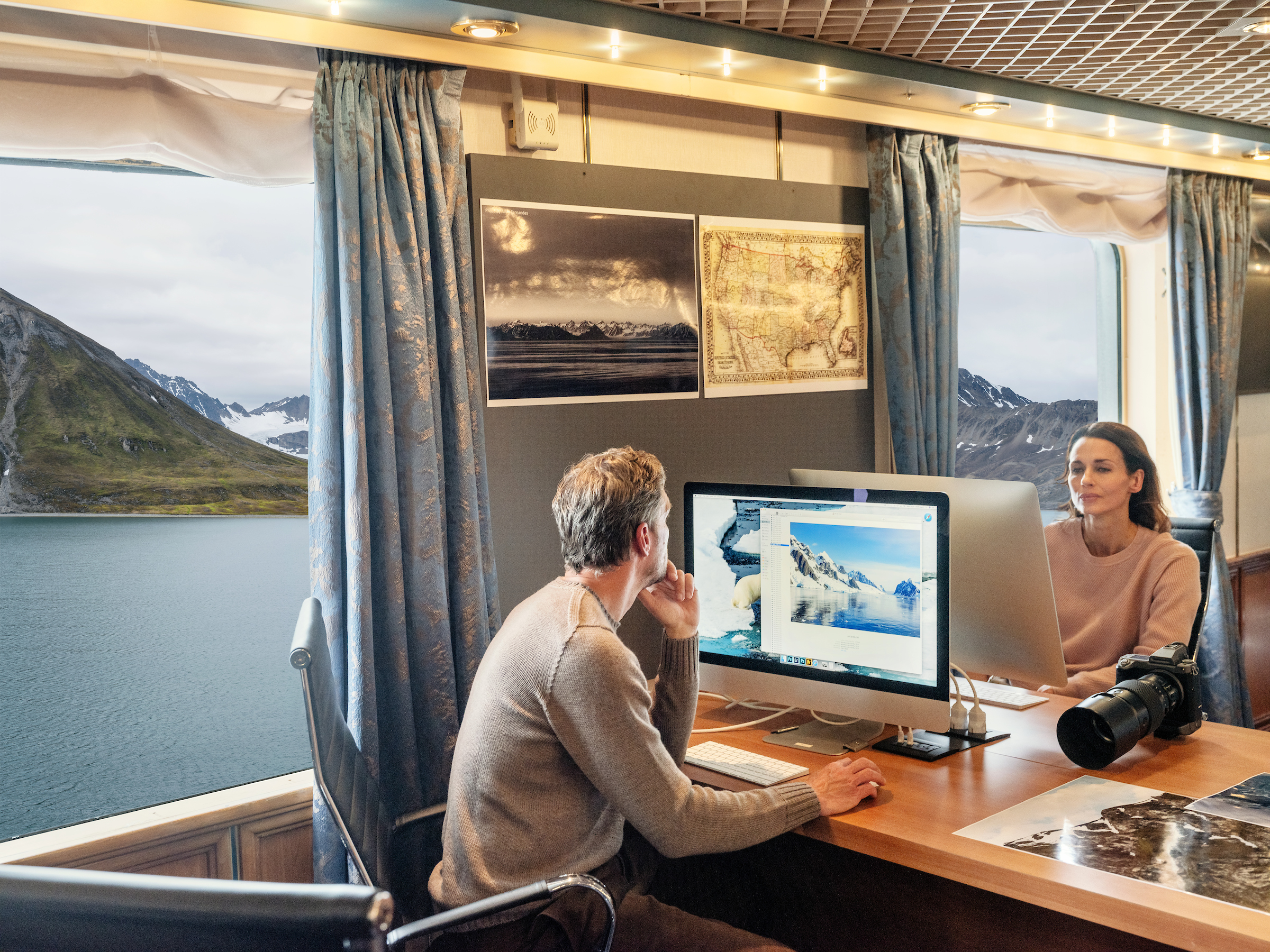
Photo Studio
The Photo Studio offers a professional space for budding photographers to retouch, print and display their work.
The Photo Studio offers a multitude of options to take your pictures from inside your camera to onto your walls. A vibrant, creatively inspiring space where you can not only master the art of digital photography with Masterclasses in editing, Adobe Lightroom and Photoshop, but also an editing suite where you can print images (including postcard, panorama and A2 prints). State-of-the-art equipment for both Mac and PC users, highly technological printers plus a dedicated photo manager to guide you through the many techniques to help you define yourself as a serious photographer. Even the smartphone photographer can become pro-level with specialized training on how to use your camera phone to its best possible advantage. Fees apply.
Images and suite plans are intended as a general reference. Features, materials, finishes and layout may be different than shown.
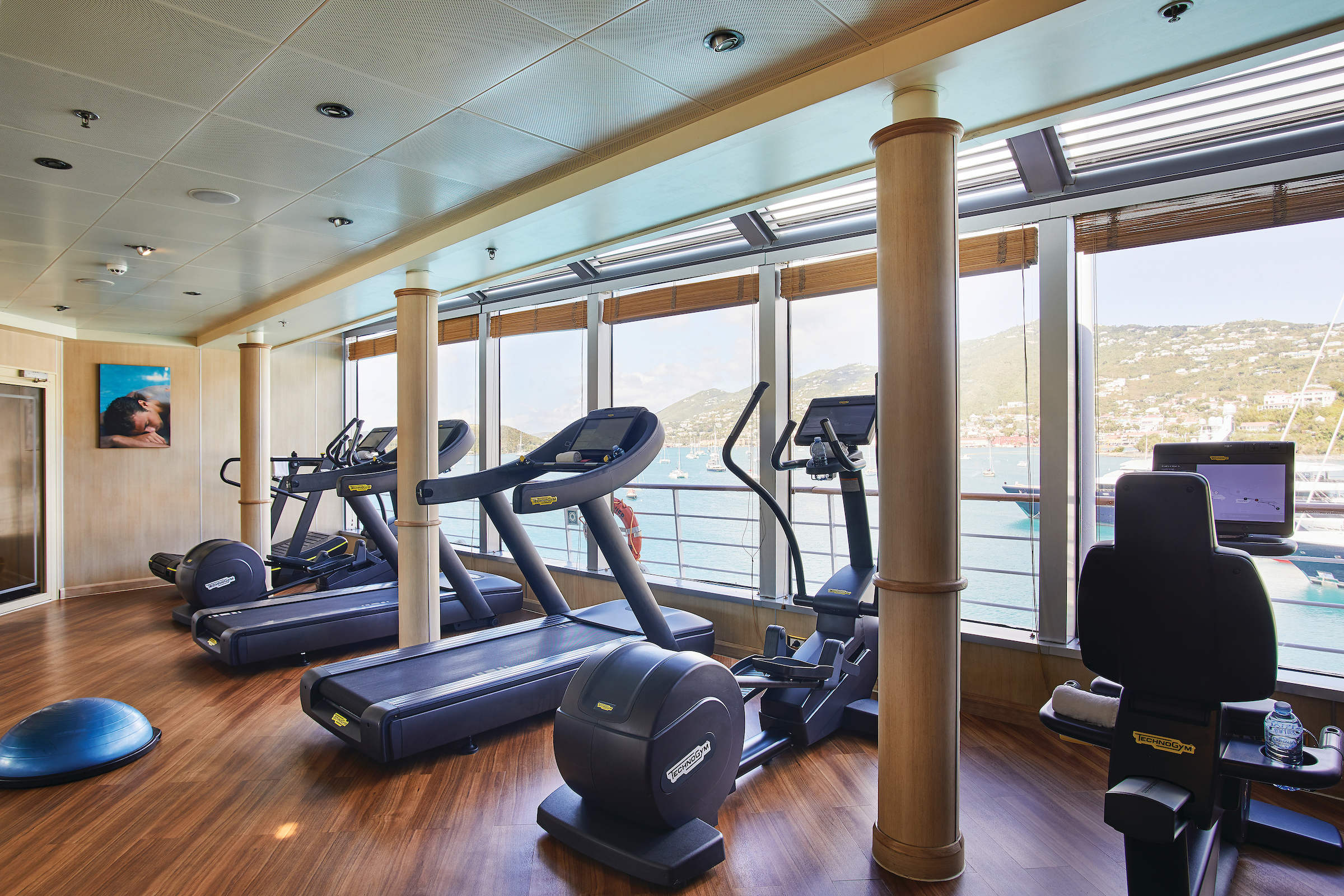
Fitness Centre
The Fitness Centre offers world-class equipment, classes, and personalised services.
The Fitness Center on board the Silver Wind luxury cruise ship is equipped with free weights, weight machines, state-of-the-art treadmills, elliptical trainers and recumbent and upright bikes. Classes in aerobics, yoga, Pilates and circuit training are led by the onboard fitness trainer and are always complimentary. Personal training, body composition analysis and specialty classes are available at the Fitness Center at an additional charge.
Images are intended as a general reference. Features, materials, finishes and layout may be different than shown.
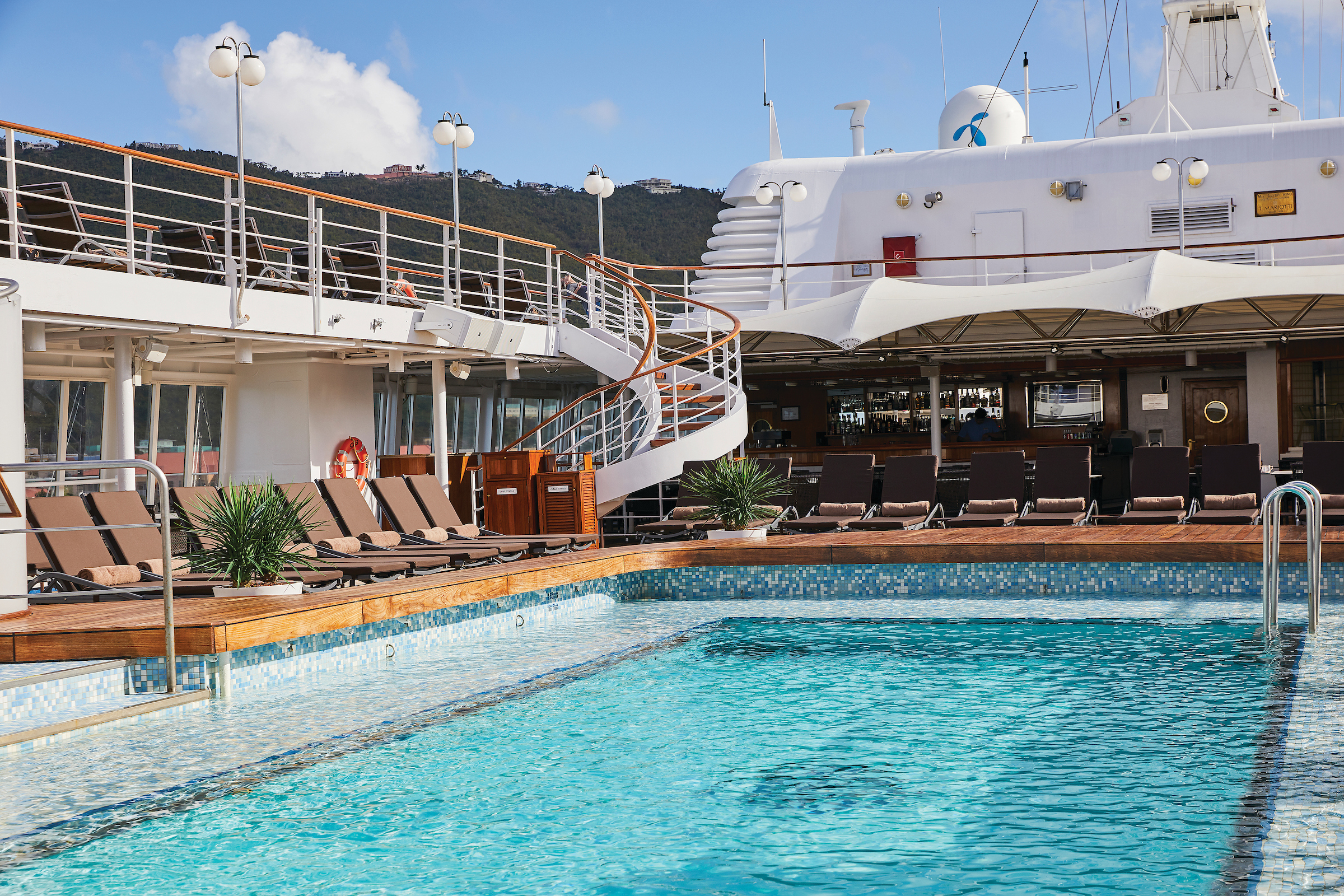
Pool Deck
Chaise lounges arranged in the sun or shade. Bubbling whirlpools. The pool water refreshing in warmer climates, heated for cooler weather. The attentive staff at the ready with an oversize towel as you emerge from the pool, with your favourite beverage at just the right moment. The luxury cruise ship of your dreams.
Images and suite plans are intended as a general reference. Features, materials, finishes and layout may be different than shown.

Zagara Beauty Spa
Come and indulge in a luxurious spa treatment. Facials, body wraps, massages – the spa is the perfect place to unwind.
Unwind on your luxury cruise with a visit to our soothing spa. Relax your body and mind in this soothing sanctuary on board this luxury cruise ship. Indulge in a wide range of invigorating therapies including facials, body wraps and massages. Appointments for spa services may be made on board the ship, or in advance via My Silversea. Men’s and women’s saunas and steam rooms are perfect for relaxing before your spa treatment or after your workout.
Images and suite plans are intended as a general reference. Features, materials, finishes and layout may be different than shown.

Zagara Beauty Salon
Maintain your fresh look throughout your luxury cruise at the Zagara Beauty Salon. Services are available for men and women.
A full range of beauty salon services, including hairstyling, manicures and pedicures, is available on board this luxury cruise ship for both men and women. Appointments for these chargeable services may be made on board the Silver Wind, or in advance via My Silversea.
Images and suite plans are intended as a general reference. Features, materials, finishes and layout may be different than shown.
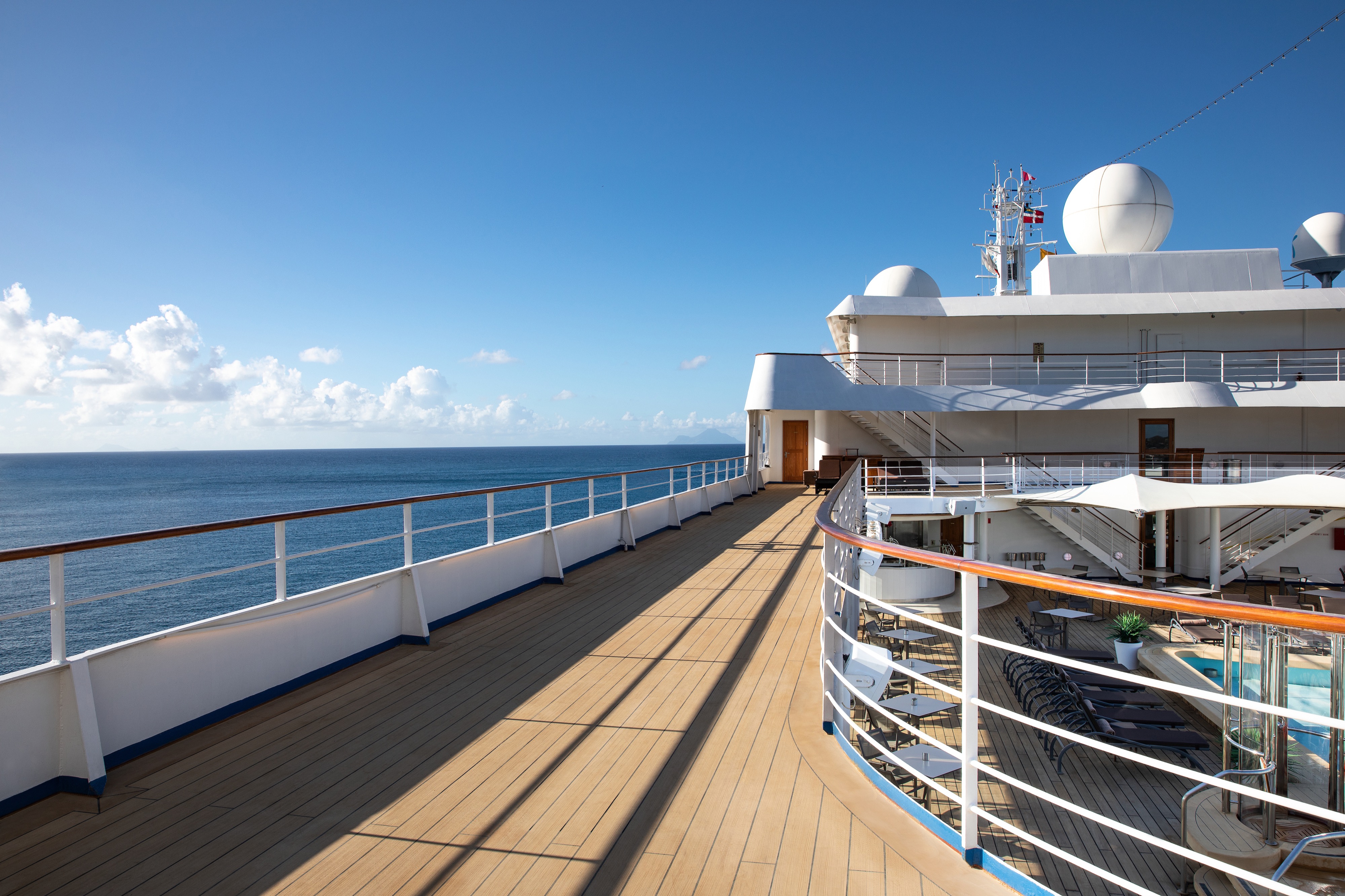
Jogging Track
A jogging track is available for guests, running the entire outside edge of the deck.
Dress Code
We have created this guide to help answer any questions you might have before you embark on your voyage. You may be wondering what you should pack in your suitcase and what kind of clothing to wear while on board and ashore. Perhaps you are unsure of what type of dress code is expected in our restaurants on board and what to wear while exploring ashore. We have provided answers here while anticipating your questions and concerns about what to wear and we hope you find it helpful. If we have not covered a specific query or concern, simply contact your travel professional or our Reservations Department.
We look forward to welcoming you on board. Bon voyage!
ON BOARD
We have a dress code on board, so we have created this overview to help you prepare.
OCEAN-GOING
Silversea has an onboard dress code after 6:00 p.m.
During the day, casual wear, similar to five-star resort sportswear, is suitable for daytime activities. It is recommended to wear flat or low-heeled shoes for deck activities.
Evening wear falls into two categories:
- Elegant Casual: On casual evenings, ladies may opt for trousers, a blouse, a skirt or a casual dress, while gentlemen may wear an open-collar shirt and dress pants. A jacket is optional.
- Formal Optional: A more formal attire may be chosen, such as an evening gown or cocktail dress for ladies and a tuxedo, dinner jacket, or dark suit with a tie for gentlemen. Alternatively, adhering to an Elegant Casual dress code is welcomed, but a jacket is still required for gentlemen in all indoor spaces.
Regardless of the daily dress code:
- After 6:00 pm, indoor spaces prohibit jeans, shorts, hats, caps, sneakers or flip-flop type footwear.
- Casual wear is always suitable in outdoor venues.
- Gentlemen dining at La Dame restaurants are required to wear a jacket.
The number of formal evenings depends on the length of the voyage. A guideline for reference is below:
- On sailings of 7 days or less, Elegant Casual nights throughout.
- On sailings of 8–14 days, expect between one to two Formal Optional nights.
- On sailings of 15 days or more, expect two or more Formal Optional nights.
EXPEDITION
Onboard Silver Endeavour, Silver Cloud and Silver Wind
Silversea has an onboard dress code after 6:00 p.m.
During the day, casual wear, similar to five-star resort sportswear, is suitable for daytime activities. It is recommended to wear flat or low-heeled shoes for deck activities.
Evening wear falls into the following category:
- Elegant Casual: On casual evenings, ladies may opt for trousers, a blouse, a skirt or a casual dress, while gentlemen may wear an open-collar shirt and dress pants. A jacket is optional.
Regardless of the daily dress code:
- After 6:00 pm, indoor spaces prohibit jeans, shorts, hats, caps, sneakers or flip-flop type footwear.
- Casual wear is always suitable in outdoor venues.
- Gentlemen dining at La Dame restaurants are are not required to wear a jacket. The use of a jacket is optional.
On board Silver Origin
On board Silver Origin, shipboard attire is always casual.
During the day, casual wear, similar to five-star resort sportswear, is suitable for daytime activities. Shoes should be non-skid, flat or low-heeled for deck activities.
Evening attire is casual; open-neck shirts, trousers and sports outfits are appropriate, with the exception of jeans and shorts, which are not permitted in The Restaurant.
ASHORE
As you’ll be traveling to some of the most remote environments on board our expedition ships, our Expedition Experts curated a packing list for each destination to help you prepare the right gear and clothing items that are essential for your upcoming adventure.
For additional expedition gear please visit Ship to Shore Traveller
How many formal nights are on my cruise, and what type of clothing is worn?
Find out what to pack. All the details are shown in the General Information section. For Silversea Expeditions guests, casual resort wear is appropriate at all times when on board, with the exception of two evenings when formal attire is required. For men, this means a jacket, tie optional.
Does Silversea offer tuxedo rental service?
No, however, the onboard boutique has a limited selection of formal wear attire for purchase.
Smoking Policy
At Silversea, the comfort, enjoyment and safety of all guests is paramount. To ensure a pleasant and safe environment, smoking is prohibited in most public areas, guest suites or suite balconies. However, cigarette, e-cigarette, cigar, pipe and vaporiser smoking is permitted in the Connoisseur’s Corner both indoors and outdoors (where applicable). In addition, cigarette, e-cigarette and vaporiser smoking is permitted in specifically designated outside areas and tables:
- Silver Nova, Silver Ray: Dusk Bar (port side);
- Silver Muse, Silver Spirit: Panorama Lounge (port side) and Pool Grill (port side);
- Silver Moon, Silver Dawn: Panorama Lounge (starboard side) and Pool Grill (port side);
- Silver Shadow, Silver Whisper: Panorama Lounge (starboard side) and Pool Grill (starboard side);
- Silver Cloud, Silver Wind: Panorama Lounge (port side) and Pool Grill (port side);
- Silver Origin: on open deck 4 aft;
Silversea kindly requests that all guests observe the non-smoking areas.
Disabled Facilities
Wheelchair guests must bring their own collapsible wheelchair. Please note that not all shore excursions are suitable for guests with impaired mobility. Silversea strongly recommends wheelchair guests travel with someone who is able to assist them both ashore and at sea as Silversea may be unable to offer special assistance. Please note that wheel-on and/or wheel-off access may not be available at some ports-of-call. Silversea reserves the right to deny boarding to any guest who failed to notify Silversea of such requirement at the time of booking.
Silversea welcomes guests with mobility needs and offers various accessibility features onboard. However, due to the nature of cruising, some destinations and excursions may present challenges. Below is a guide to help guests plan their journey.
BEFORE BOOKING
Do guests need to notify Silversea in advance about mobility needs?
Yes, guests should inform Silversea of any special assistance or mobility equipment requirements before sailing. This can be done via My Silversea under Guest Information / Special Request, or by contacting specialservices@silversea.com.
Does Silversea provide wheelchairs?
Yes, each vessel has wheelchairs available at the reception for temporary use, such as embarkation and disembarkation. Guests who require a wheelchair for the entire cruise should bring their own.
Can guests bring their own mobility equipment?
Yes, personal wheelchairs, scooters, and other mobility aids are allowed. However, guests staying in standard (non-ADA) suites should note that electric scooters may not fit through the doors.
Therefore, guests traveling with a wheelchair, scooter, or ECV are always highly suggested to book a wheelchair-accessible suite with a wider entrance door and an appropriate path of travel inside the room and accommodate the equipment. Regular Suites have a narrower entrance door and may not have the necessary interior space to accommodate wheelchairs and scooters.
What features do wheelchair-accessible suites offer?
Silversea ships offer specially designed suites for guests who require mobility assistance. These suites are equipped with wider entrance doors and appropriate paths of travel to accommodate wheelchairs, scooters, and other mobility equipment. All areas within these suites are reachable without the need for additional ramps, except for Silver Suites onboard Silver Moon and Silver Dawn and Classic Veranda onboard Silver Endeavour. In these suites Silversea offer ramp to go outside the balcony. The vessels also have wheelchairs available at the reception for guest use.
Where to find the information regarding the disabled access suites?
This information is visible under the Suite tab by suite category.
Also, can be found on the deck plan after clicking on the “View Deck Plan” tab on the ship page. The disabled access suites are indicated with the universal accessibility icon.
EMBARKATION & DISEMBARKATION
How do guests get on and off the ship with mobility equipment?
Silversea vessels have procedures in place to assist guests with mobility equipment during embarkation and disembarkation. When the gangway is flat, guests can drive their wheelchair off the ship. However, if the gangway involves stairs, our staff will provide assistance. The Safety Officer or Bridge must be informed whenever a wheelchair is involved in disembarkation or boarding, and our crew members are available to assist guests in need.
Is assistance available for boarding?
Yes, but guests who require full-time assistance should travel with a companion, as Silversea does not provide dedicated personal caregivers. Butlers can assist with getting to the gangway or dining venues but do not provide continuous mobility assistance.
ONBOARD
Silversea’s ships are designed for accessibility, featuring:
- Wide gangways to accommodate most wheelchairs and scooters
- Accessible public restrooms
- Wheelchair seating in dining venues, bars, and the Venetian Lounge
- Braille/tactile signage for visually impaired guests in elevators, stateroom numbers, and staircases
How does Silversea assist disabled guests in their suites?
Silversea butler can provide reasonable assistance to guest getting to and from the gangway, and to and from a restaurant, however Silversea does not offer full-time wheelchair service and/or staff fully dedicated to providing Guests with wheelchair assistance. Guests traveling on their own wheelchair should be assisted only when requested and are recommended to travel with an able bodily companion.
GOING ASHORE
Are all ports wheelchair accessible?
Not all ports have wheelchair-friendly infrastructure. In some destinations, tender boats or on Silversea Expeditions Zodiacs are required for disembarkation, and wheelchairs or mobility scooters cannot be accommodated in these cases.
Can guests arrange private accessible transportation in port?
If available, private wheelchair-accessible vehicles can be arranged. In some ports, shuttle buses may be wheelchair accessible, but availability is not guaranteed.
Does Silversea offer wheelchair-accessible shore excursions?
Until now we have been offering dedicated “Wheelchair Accessible Excursions” in some areas of the world., These tours are operated by wheelchair accessible vehicles and include only wheelchair accessible venues. These tours are mainly offered in Europe and the US. If you have any questions or concerns regarding shore excursion suitability, please contact the Shore Concierge (shoreconcierge@silversea.com) before your voyage or visit the Shore Concierge desk for more detailed information once onboard.
Wheelchair accessible shore excursions are indicated on the website with the universal accessibility icon.
Are there alternatives for guests with limited mobility?
In almost every port, Silversea offers low-activity excursions specially designed for mobility challenged guests, who can negotiate the steps on and off the coaches.
Is there any destination that is not recommend to guests with disabilities?
The more exotic destinations, like Asia, South Africa and South America it is recommended to guest to book a private vehicle due to the lack of infrastructure, for example wheelchair accessible vehicles are very rare to find and museums, restaurants and popular attractions are not often completely accessible.
Does Silversea offer wheelchair-accessible transportation between the ship and visiting site?
If available in the port yes, however this is not often available.
How Silversea assist disabled guests during excursions?
If wheelchair accessible excursions are not available, it is recommended to guests to book a private vehicle where they can have a dedicated guide and driver who can give them full attention. On regular shore excursions, the guide must look after all guests and may not be able to fully assist disabled guests.
Special Dietary Requirements
If you have special dietary requirements, Silversea will make every attempt to accommodate your requests. Please advise Silversea of your needs on the Guest Information Form at least 75 days prior to sailing. Notification should be sent to specialservices@silversea.com
Medical Centre
Each Silversea ship is equipped with a Medical Centre, which is staffed by a doctor and nurse on 24-hour call when at sea. When docked, supplementary emergency care may also be obtained through local medical facilities. Guests may be charged for medical services and for medications used for their medical treatment. The Medical Centre is not intended or designed to provide on-going treatment of pre-existing conditions or for extended critical care, and Silversea is not responsible for the diagnosis, treatment or services furnished by shipboard medical personnel.
All guests are required to report in writing to Silversea at the time their reservation is made:
- Any physical or mental condition that may require medical or professional treatment or attention during the voyage
- Any condition that may render the guest unfit for travel, or that may require special care or assistance
- Any condition that may pose a risk or danger to the guest or anyone else on board the ship
- Any condition that may require oxygen for medical reasons
- Any intention or need to use a wheelchair aboard ship.
Age Restrictions
Applicable to all ships: Minors under the age of 18 must be accompanied, in the same or connecting suite, by a parent or other responsible adult over the age of 21 for the duration of the voyage and on all shore excursions and land programs. If the adult accompanying the minor is not their parent, a parental consent guardianship form must be signed by a parent or legal guardian and received by Silversea prior to sailing. Please contact our Special Services department at SpecialServices@Silversea.com for a Parental Consent Form. Silversea cannot accommodate infants under six months of age and reserves the right to limit the number of children under three years of age. Guests must be 21 years of age or older to consume alcohol. Silversea reserves the right to refuse to serve anyone who in its sole judgment may be under the influence of alcohol, or for any reason necessary to preserve the health and safety of guests and employees. Children under the age of eight years old are only permitted to participate in suitable Silver Shore Excursions / shuttle service if the vehicles are equipped with the correct safety harness and seating equipment. Child harnesses and secure seating cannot be guaranteed. Silversea reserves the right to refuse children under the age of eight years old on any tour on the basis of safety. Guests may use their own approved safety seat, booster seat or harness provided they are compatible with the local touring vehicle and can properly secure the child.
Laundry Service
Complete valet services, including laundry, pressing and wet cleaning, are available at an additional charge and may be arranged through your butler. Laundry service is complimentary on higher category suites (Premium Medallion, Medallion, Silver, Royal, Grand, Junior Grand, Signature, Master, Otium and Owner’s Suites) and for those Venetian Society members who have reached certain reward levels. click here to learn more. A self-service laundromat offers washing machines, dryers, irons and laundry supplies, allowing you to limit the amount of cruise luggage needed, especially for longer voyages.
Wi-FI & Internet
All Silversea ships are equipped to offer wireless (Wi-Fi) Internet access. You can use your own laptop to surf the Internet and check emails at Wi-Fi locations throughout the ship, or from the comfort and privacy of your suite. Computers, email and Internet access are also available on board at the Internet Café. However, it is important to understand that telecommunication services while at sea are via satellite and significantly different than high-speed connections on land back home. The signal travels in a similar manner to radio waves but at much greater distances. Therefore, onboard Internet access is not guaranteed at all times. Satellite communications are also affected by weather and the ship’s location. In particular, Internet service is extremely sporadic while in the Arctic. Guests aboard expedition cruises to/from Svalbard should be prepared to be out of communication for the duration of their time on board.
Onboard cell phone service enables you to make and receive phone calls, text messages and other select data services on your cell phone even when miles away from land. Your cell phone service provider will bill you for calls and/or messages, which may appear as roaming charges. Please note that cell phone service is sporadic at best while in the Arctic. Guests aboard voyages to/from Svalbard should be prepared to be out of communication for the duration of their time on board. Click here for more information on Silversea’s Cellular Phone service.
Will my devices work on board?
To be most successful, prepare your devices BEFORE leaving home:
- Learn how to turn ON and turn OFF both the Wi-Fi and network (mobile/cellular) connections on each of your devices.
- Contact your mobile/cellular service provider to confirm that a roaming agreement with Silversea Cruises has been established and to ask about rates. Learn how to enable your international roaming
- Set up an email account if you do not have one already.
- Be sure you know any usernames and passwords you may need.
- Switch your settings to the most basic choice that shows less graphics and loads faster.
- Make any software updates and turn off any automatic update settings for the duration of your cruise.
- Download any books, audiobooks, music, movies, games, apps, etc. that you may want during your cruise.
- Facebook users should bookmark and plan to use M.Facebook.com or Touch.Facebook.com instead as these have less graphics and load faster.
- Don’t forget to pack any power cords/battery packs, camera cables to transfer pictures, adapter cables and headphones you may need for each of your devices.
Will I be able to download videos and stream music?
Certain websites and services may be restricted due to limited bandwidth. Downloading videos, books and movies or using Skype are examples of high-bandwidth services that will be more frustrating than enjoyable and should be avoided. Plan to use the Internet only for emailing and web browsing.
How can someone contact me on the ship?
In the case of an emergency back home, friends and family should not call your cell phone. The Shore-to-Ship number provided in your Final Cruise Documents is the best way to reach you while aboard ship. Click here for more information on Dial A Ship service, an alternate option for contacting ships at sea, anywhere in the world.

Deck 9
- Fitness Centre
- Beauty Salon & Spa
- Observation Library
- Jogging Track

Deck 8
- Pool Deck
- Pool Bar
- The Grill
- Panorama Lounge
- Connoisseur’s Corner
- Whirlpools
- Medallion Suites

Deck 7
- La Terrazza
- Grand Suites
- Classic Veranda Suites
- Silver Suites
- Deluxe Veranda Suite
- Owners Suites
- Vista Suite
- Medallion Suite

Deck 6
- The Show Lounge
- Conference Room
- Reception
- Expedition Office
- Future Cruise Manager
- Lobby
- Shore Concierge
- Silver Suite
- Classic Veranda Suites
- Deluxe Veranda Suites
- Royal Suites

Deck 5
- Photo Studio
- Lobby
- Dolce Vita
- Boutique
- Silver Suite
- Classic Veranda Suites
- Deluxe Veranda Suites

Deck 4
- The Restaurant
- La Dame
- Launderette
- Vista Suites (x2 Accessible Suites)

Deck 3
- Changing Room
- Embarkation Deck
- Medical Centre
